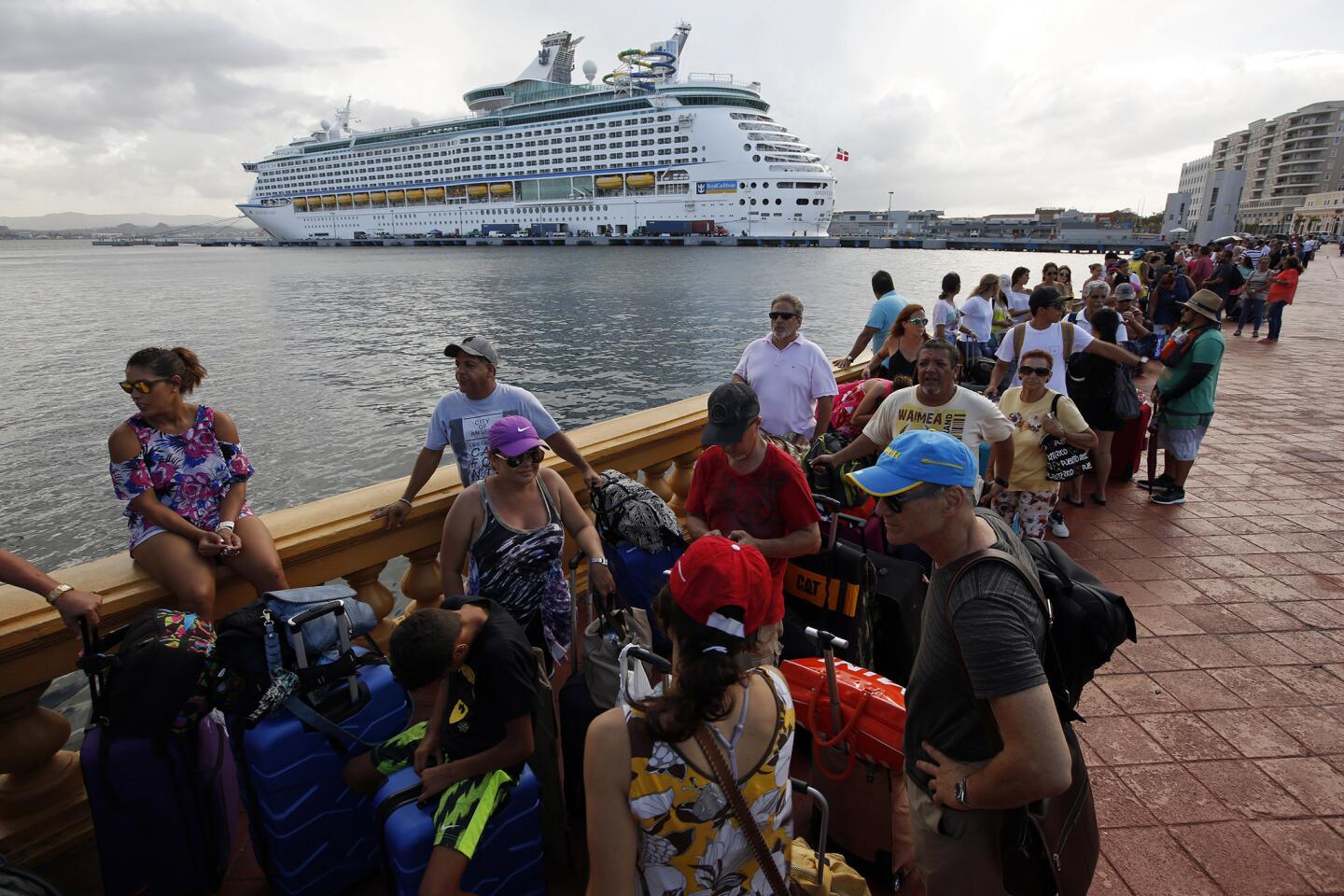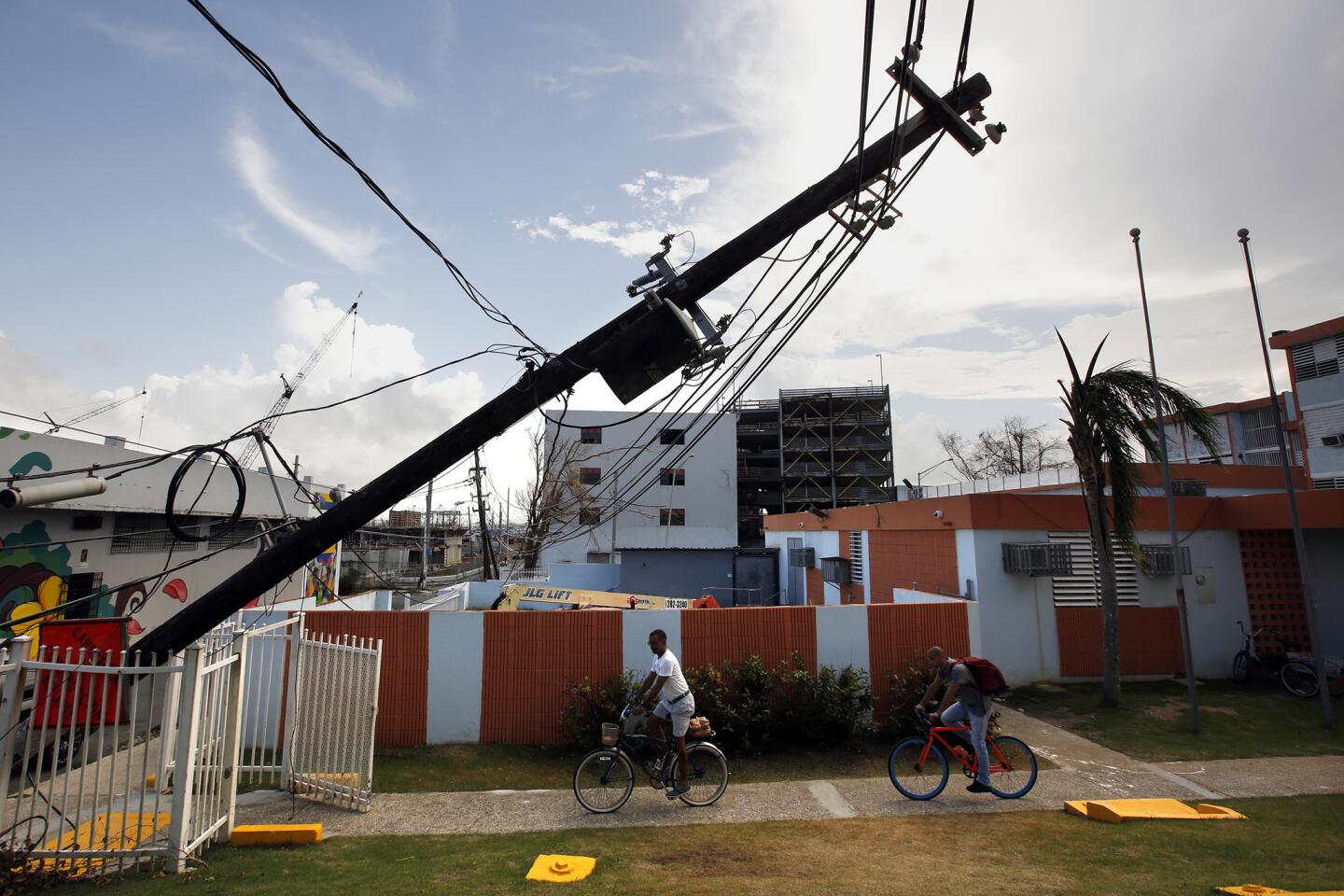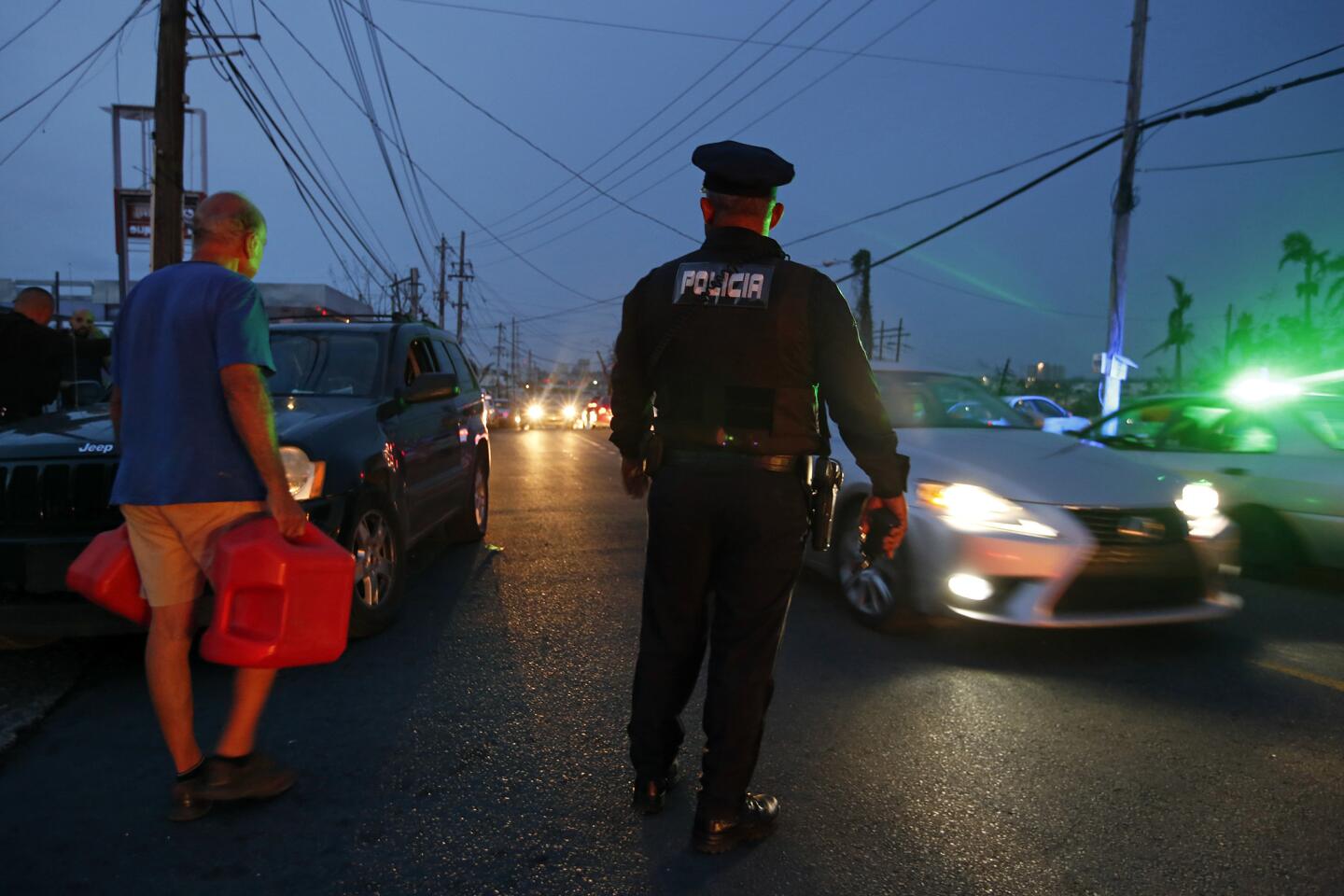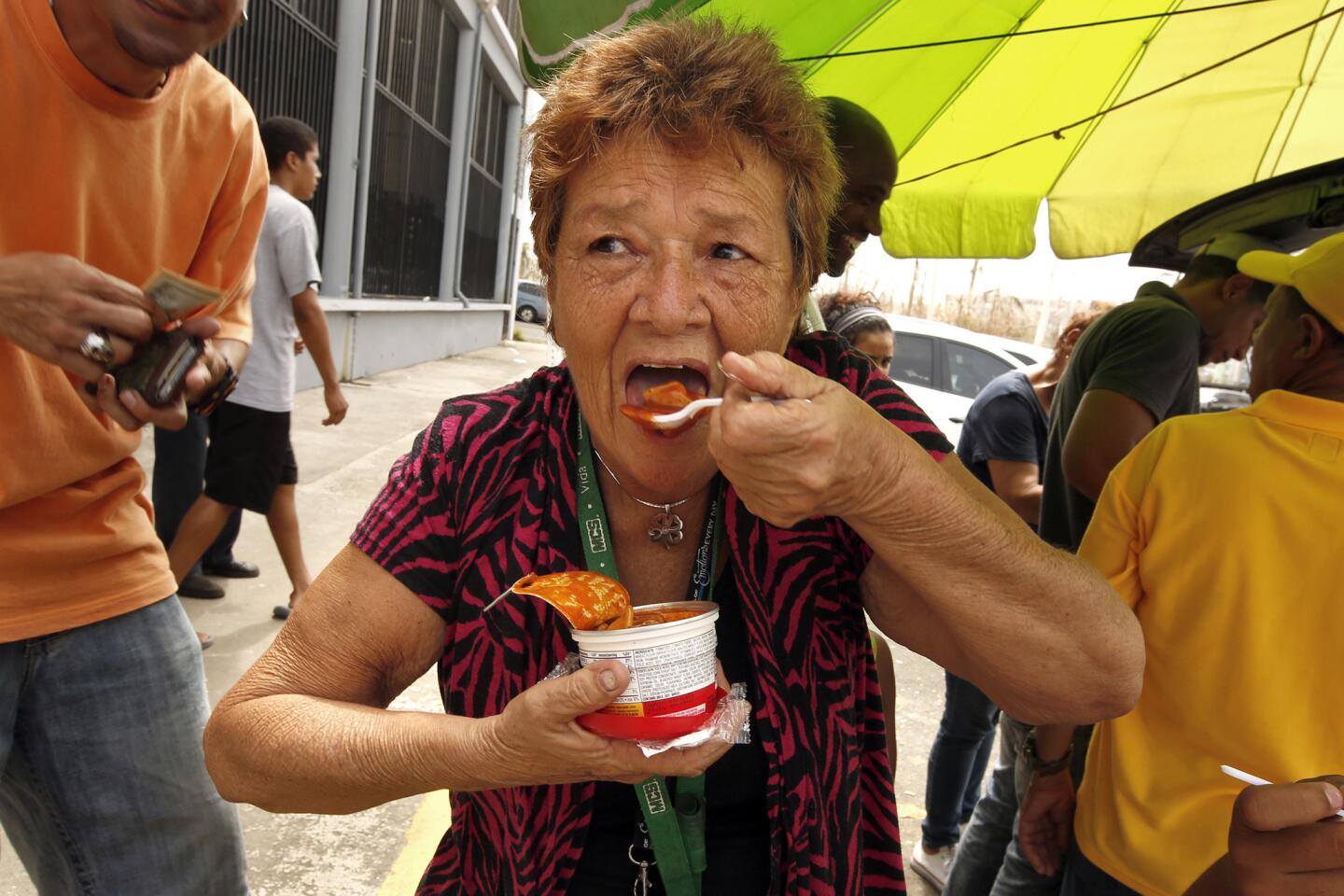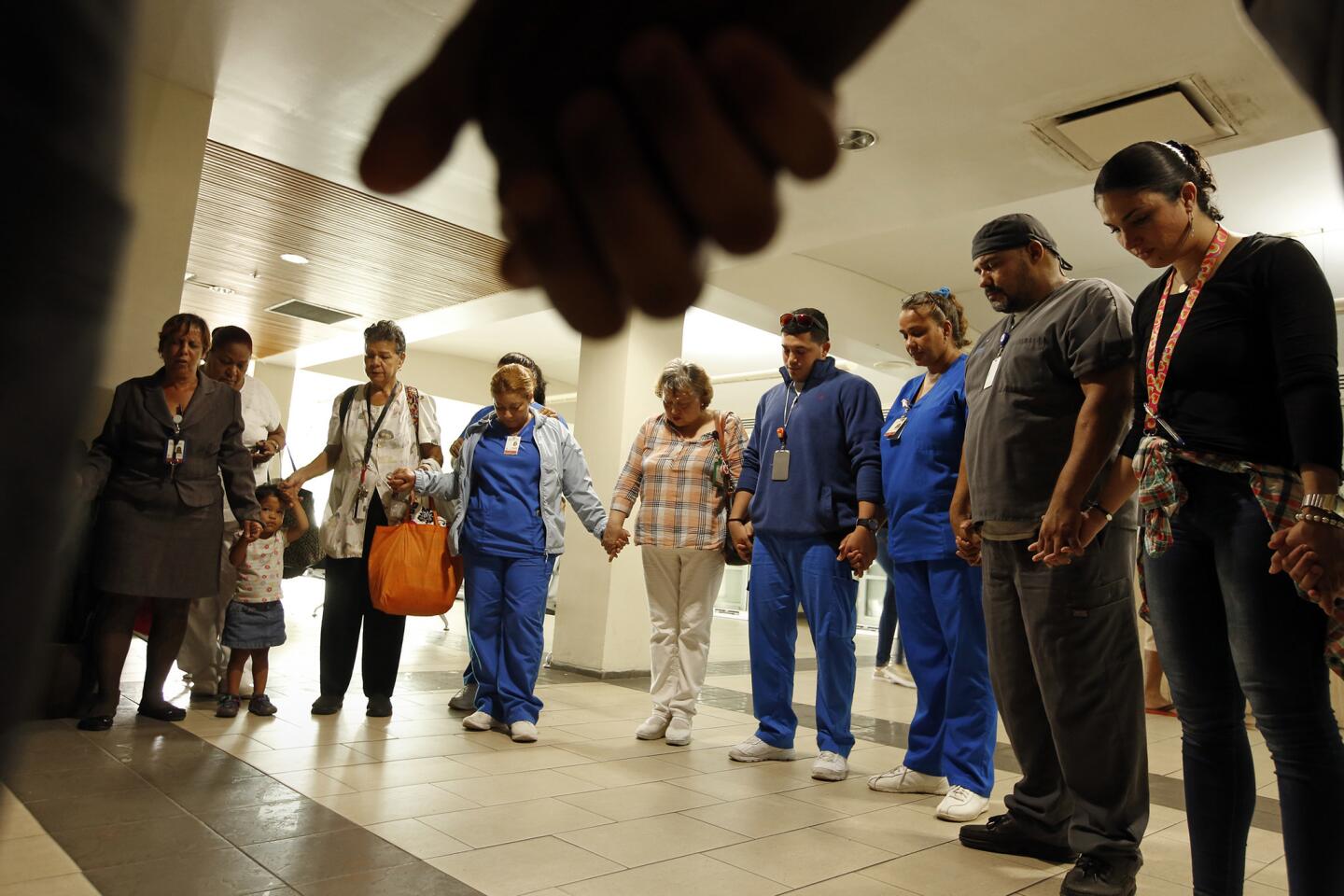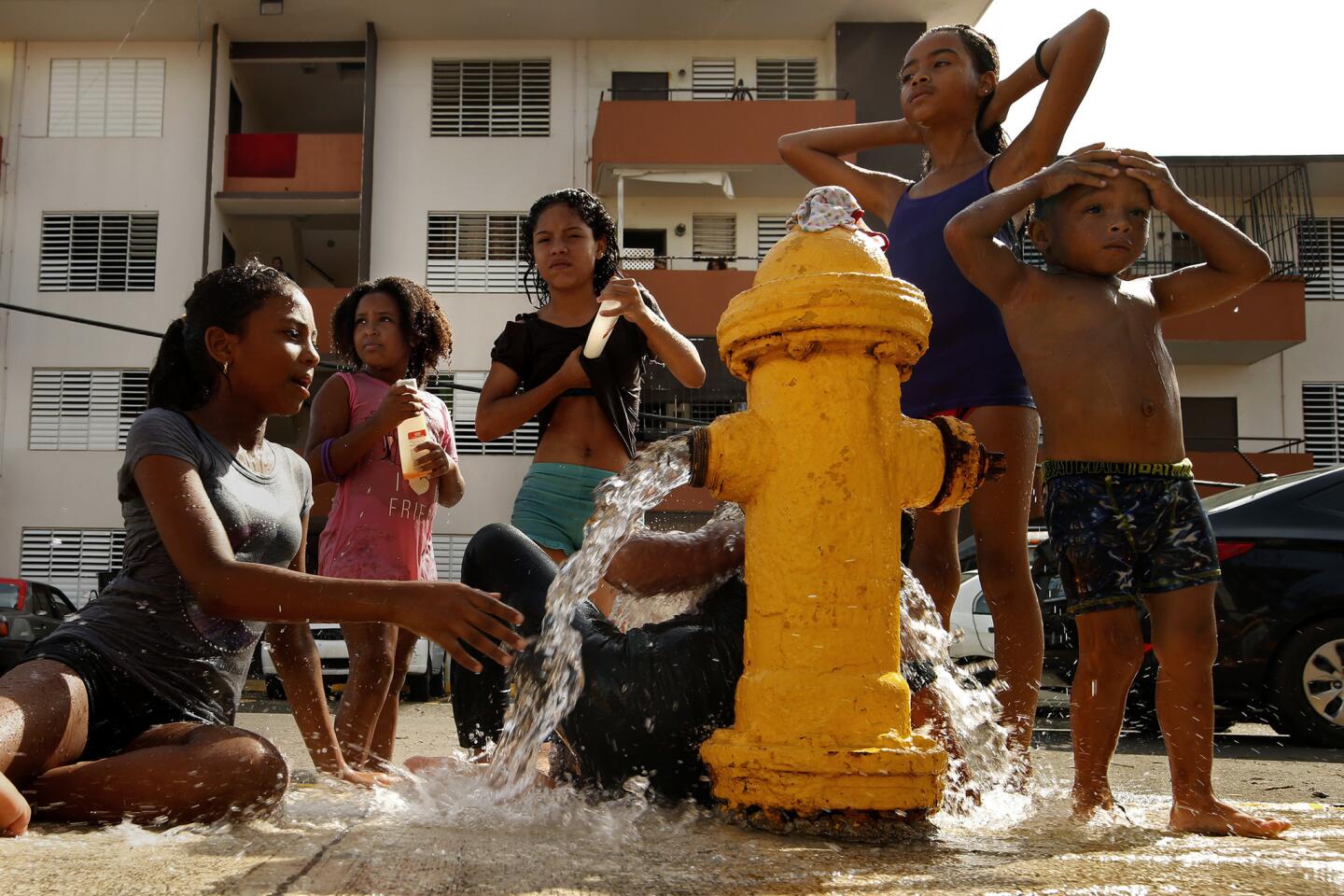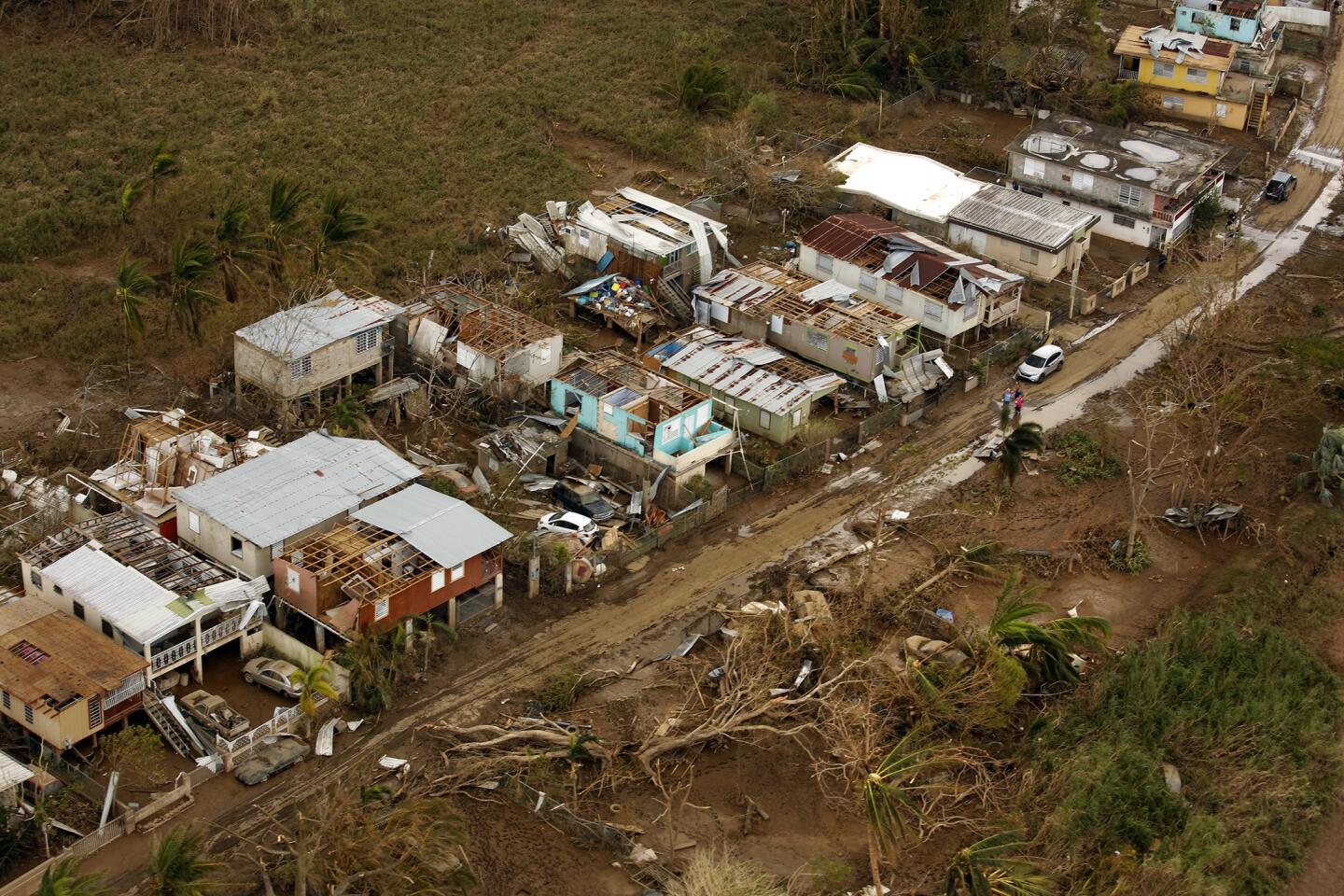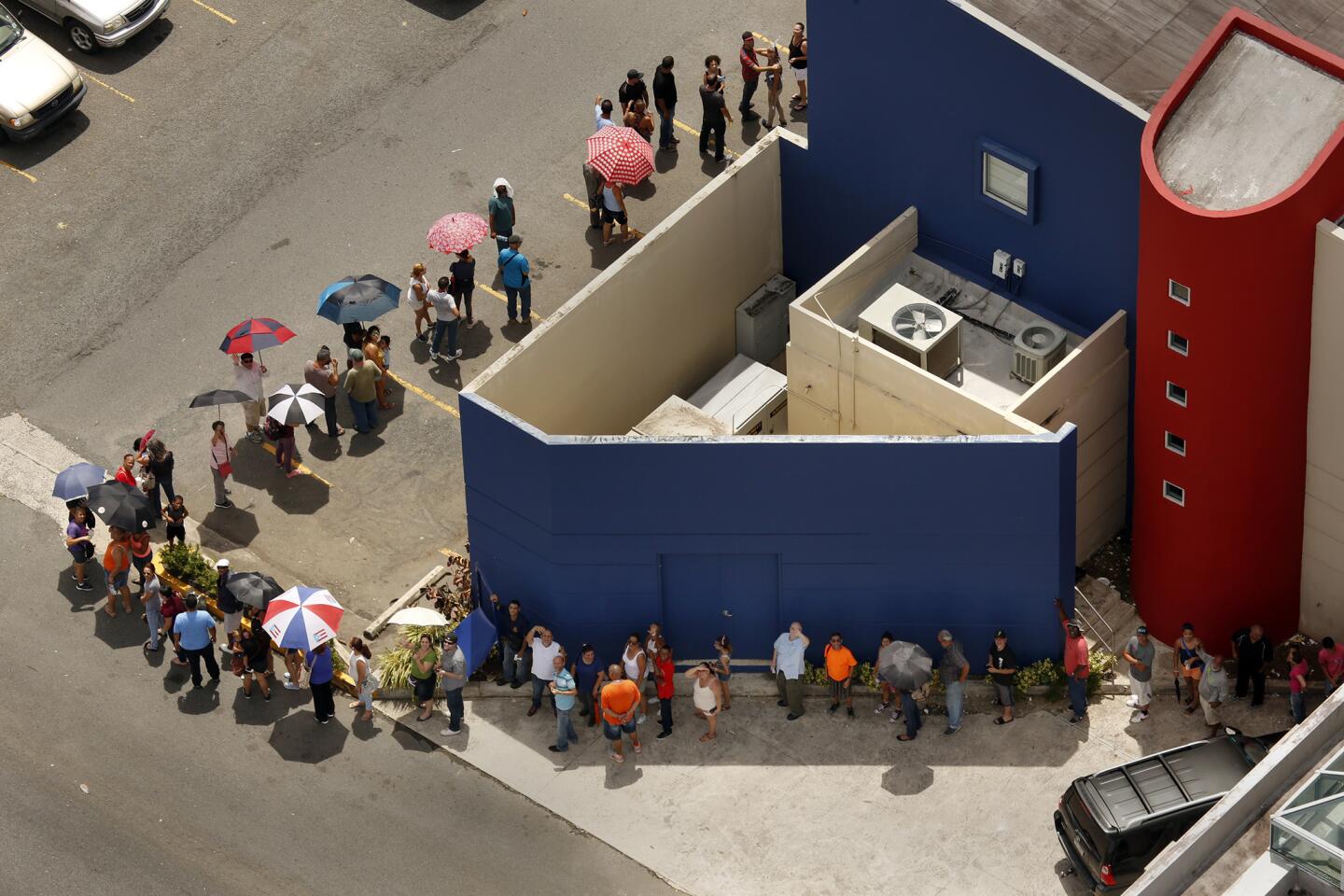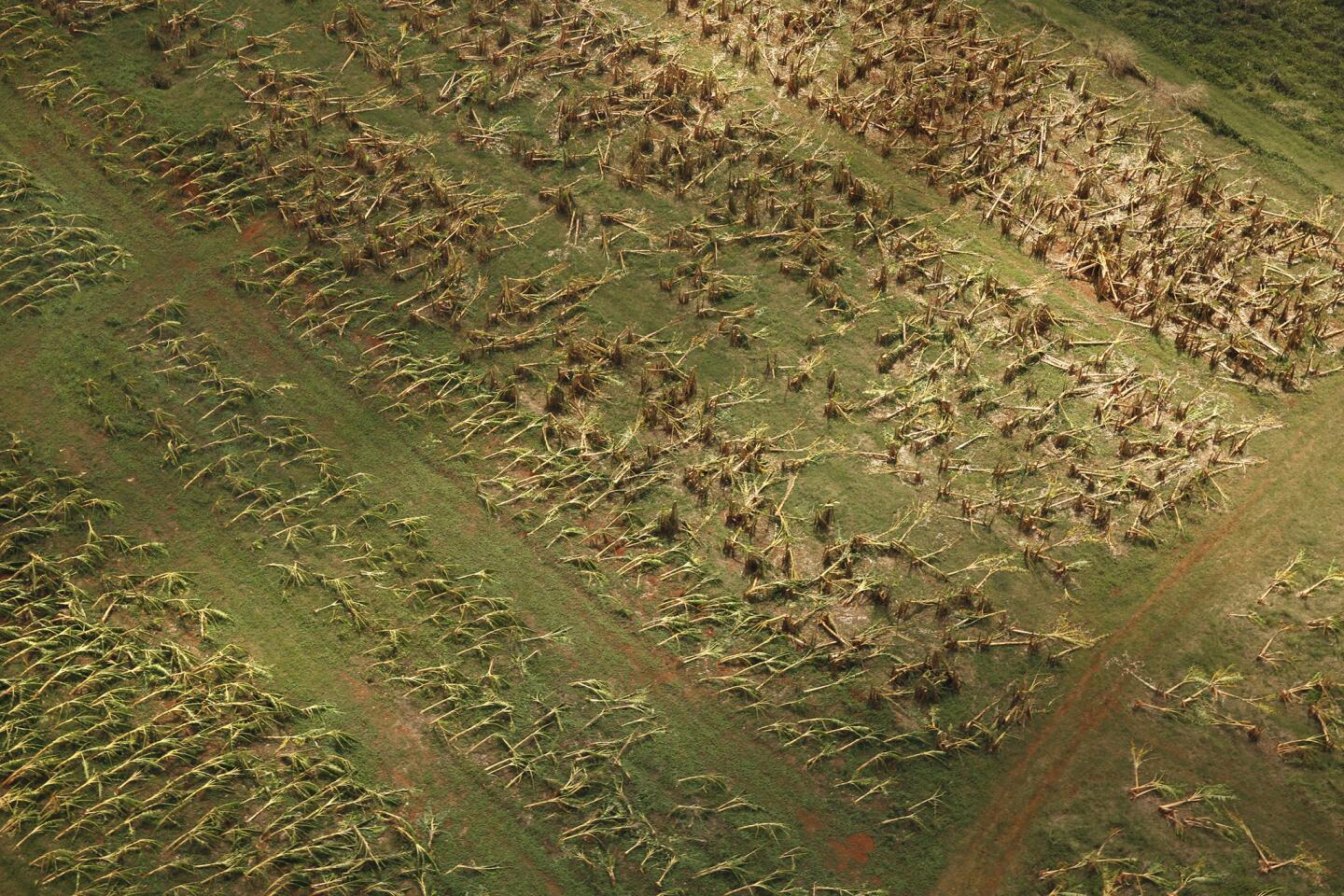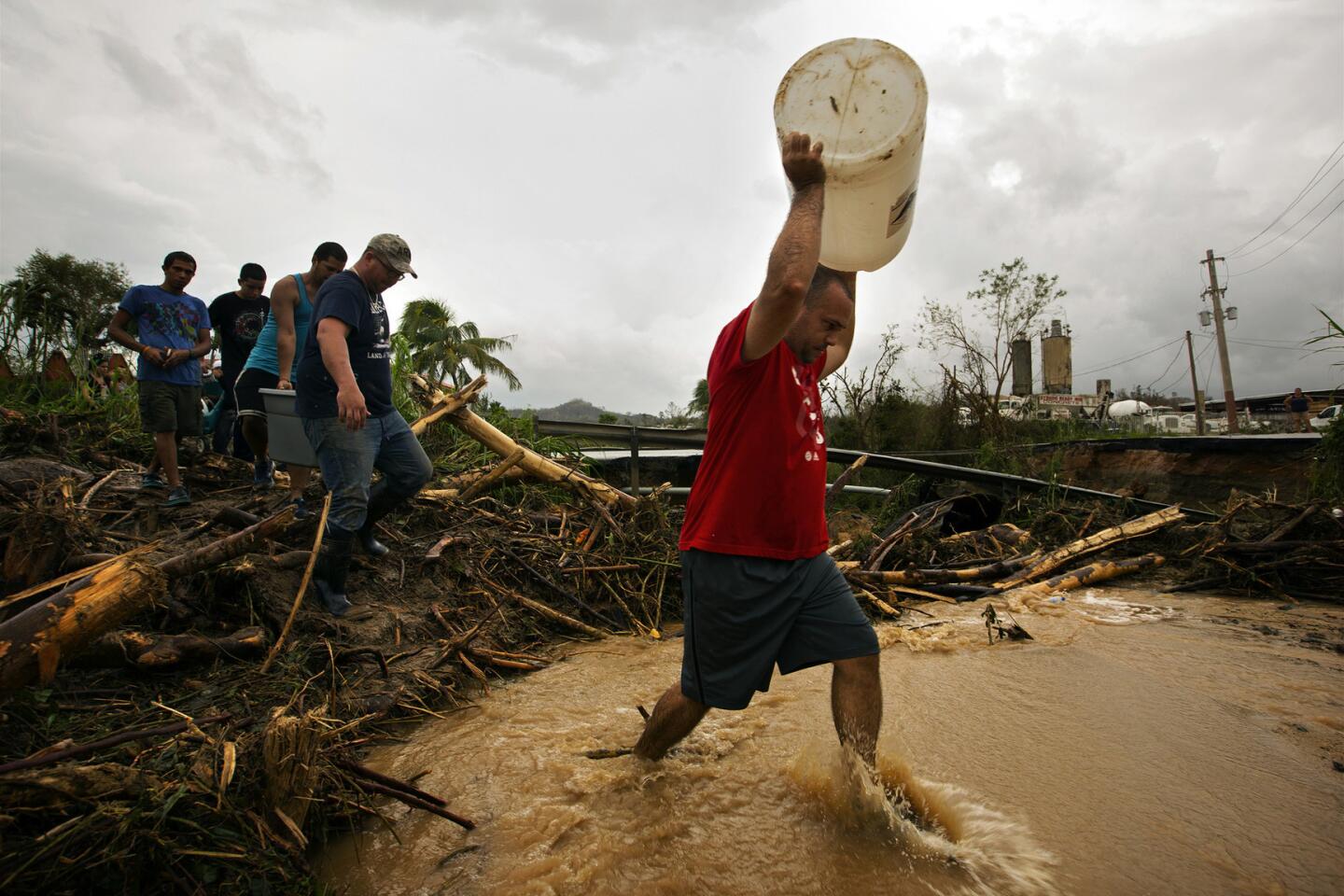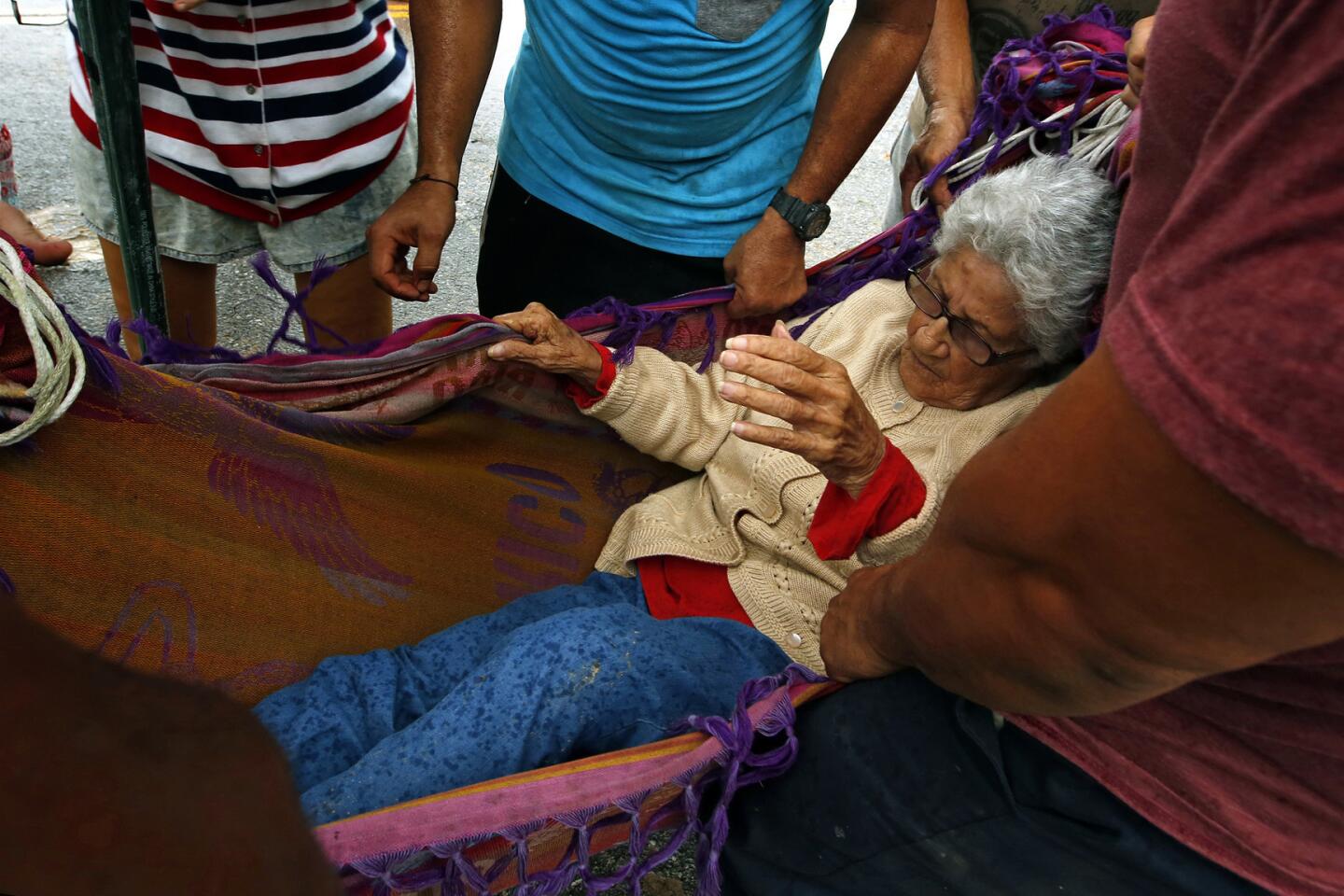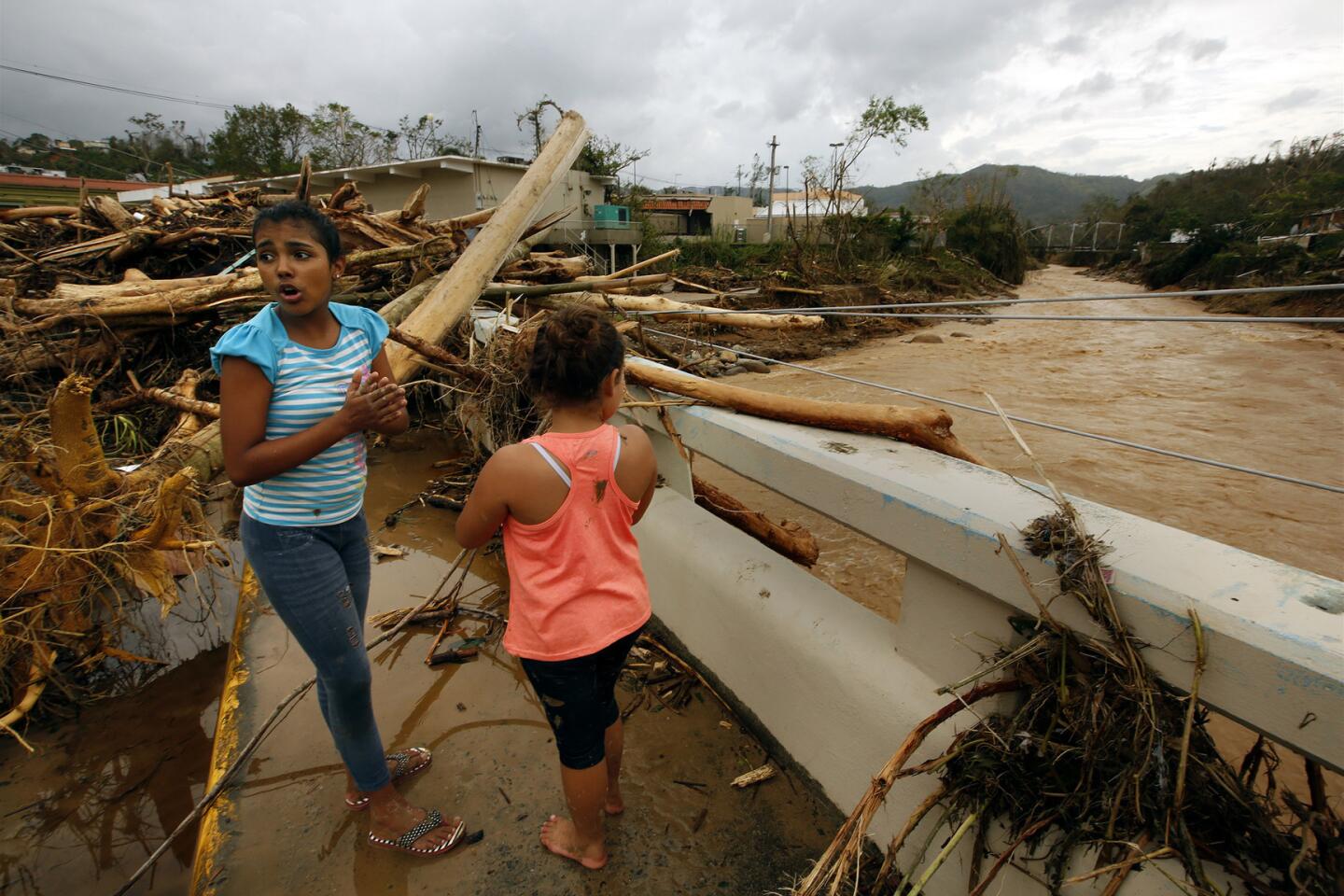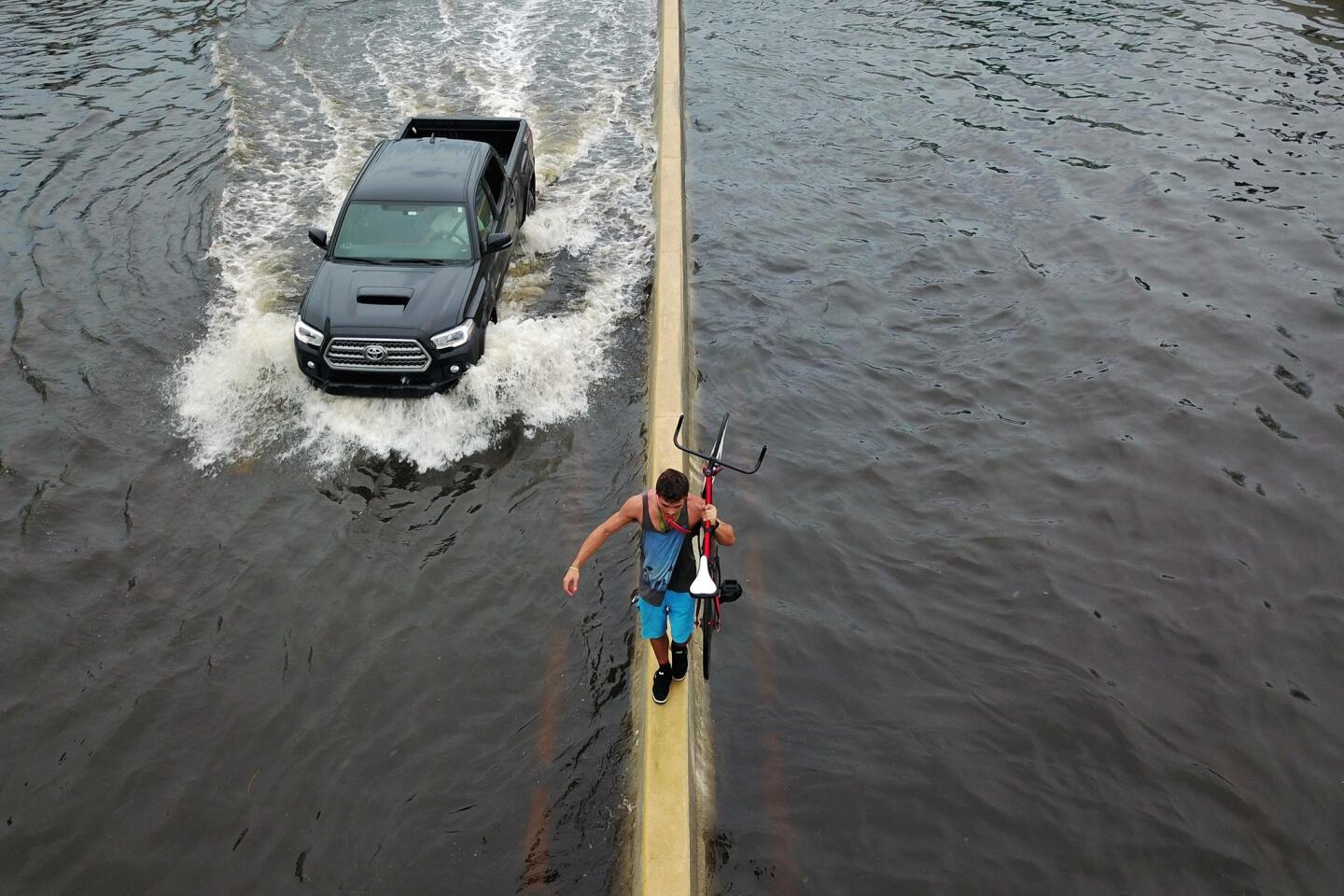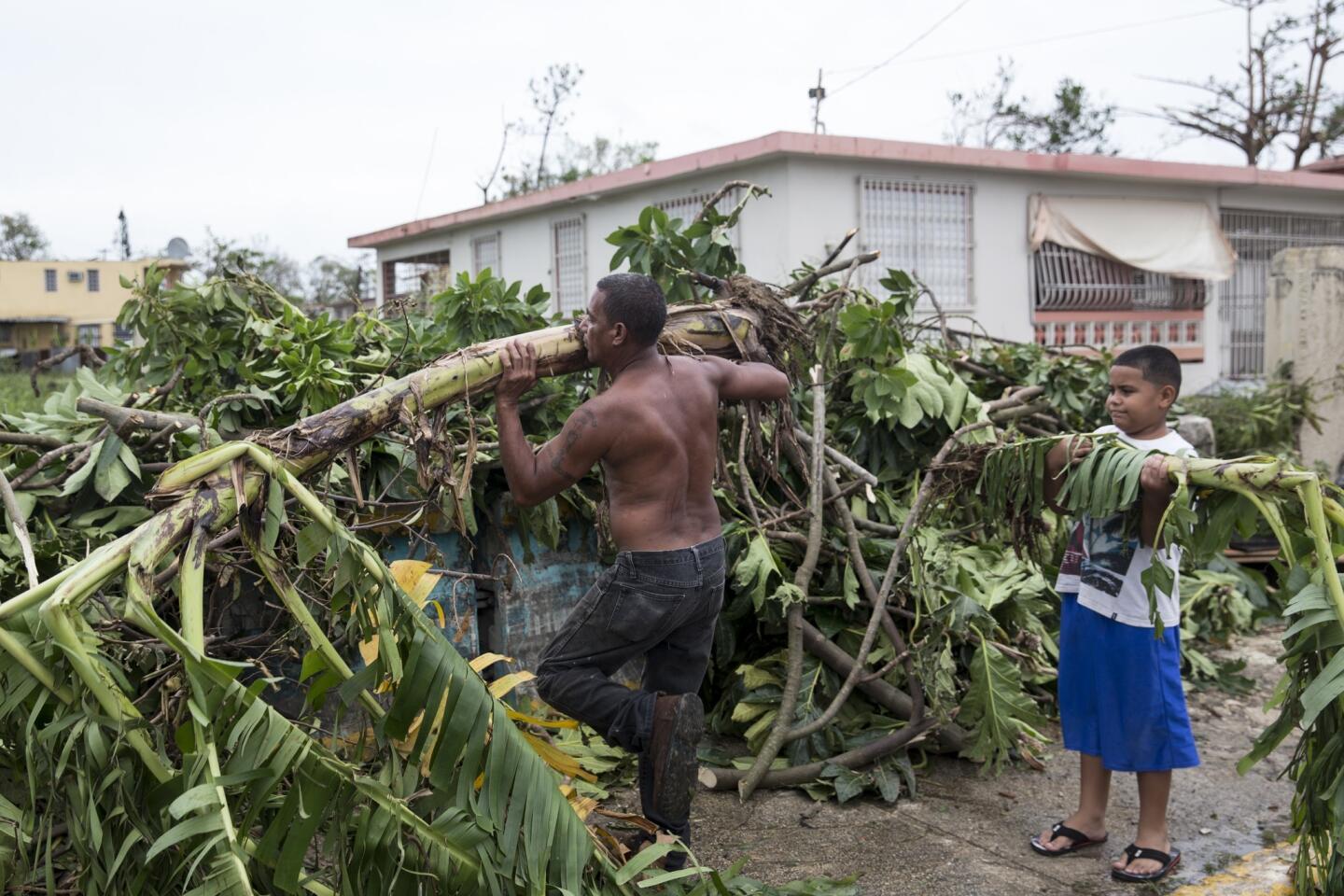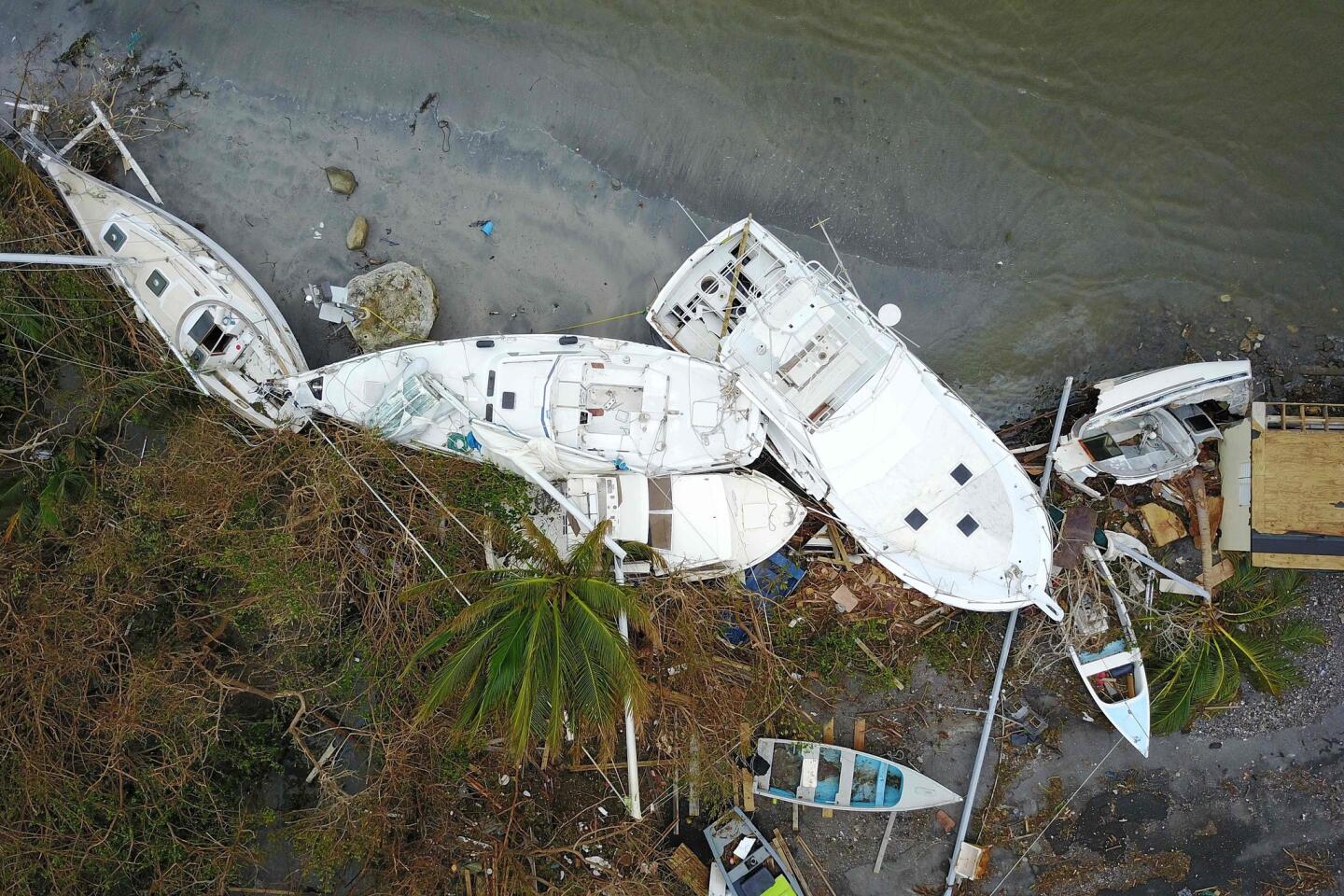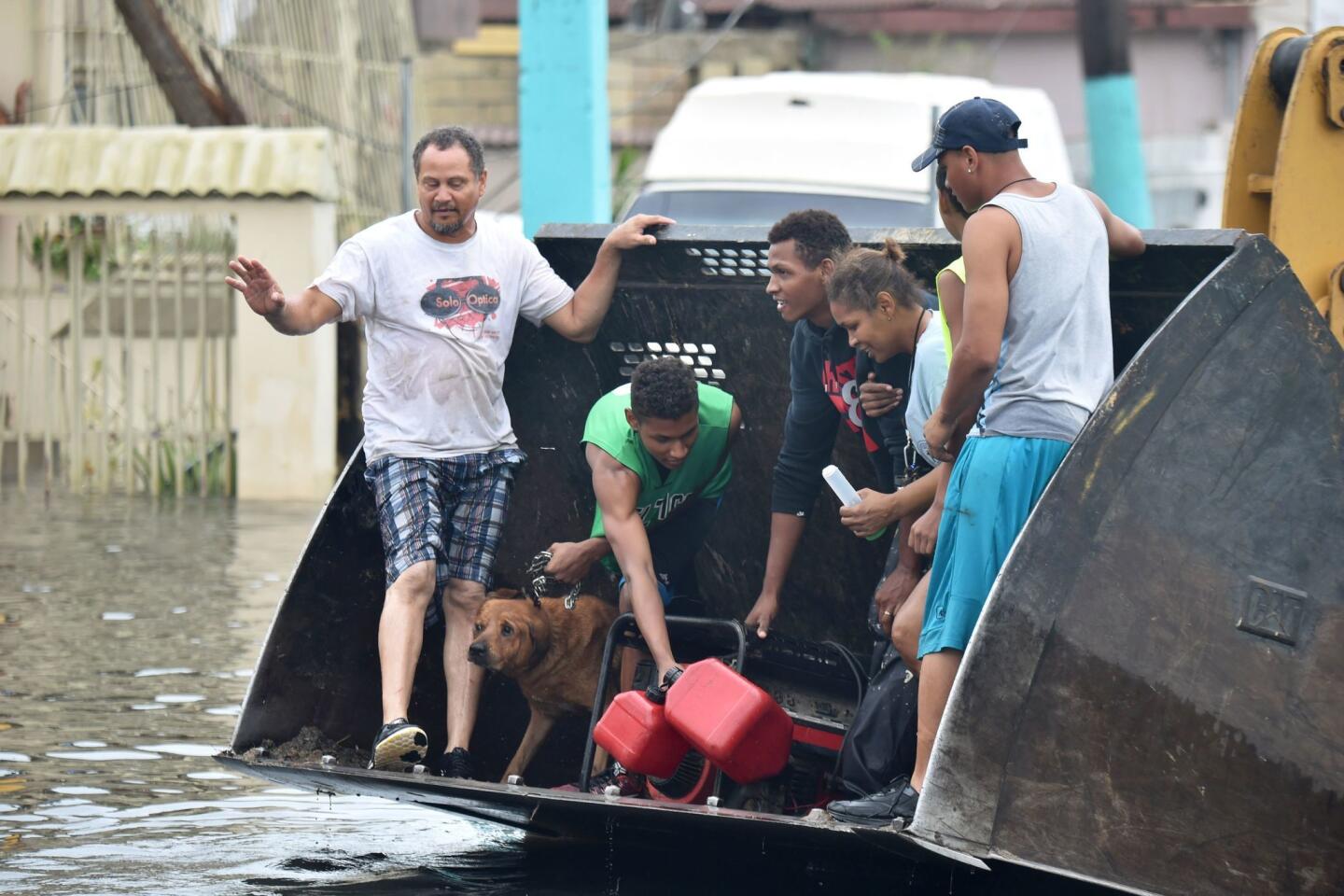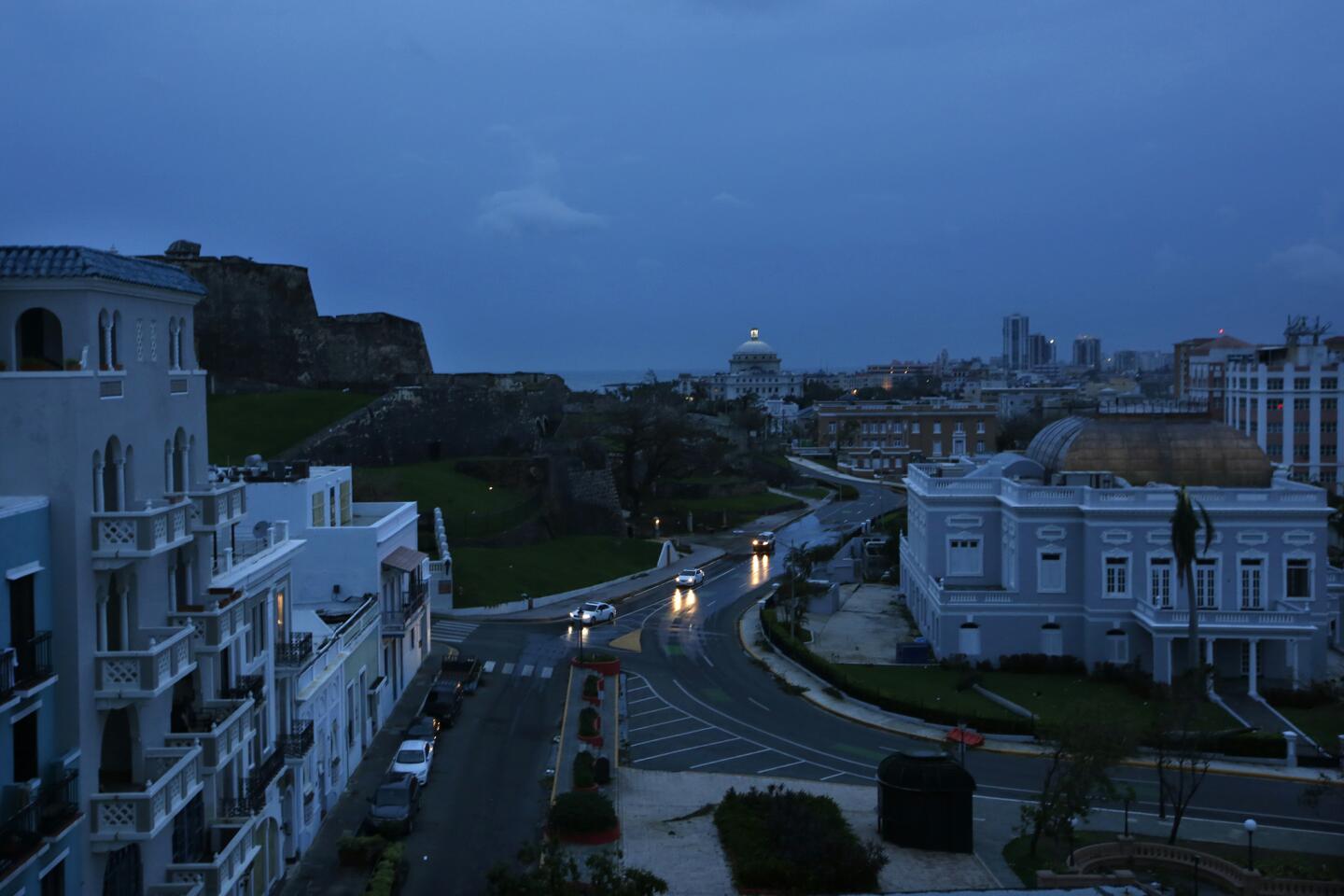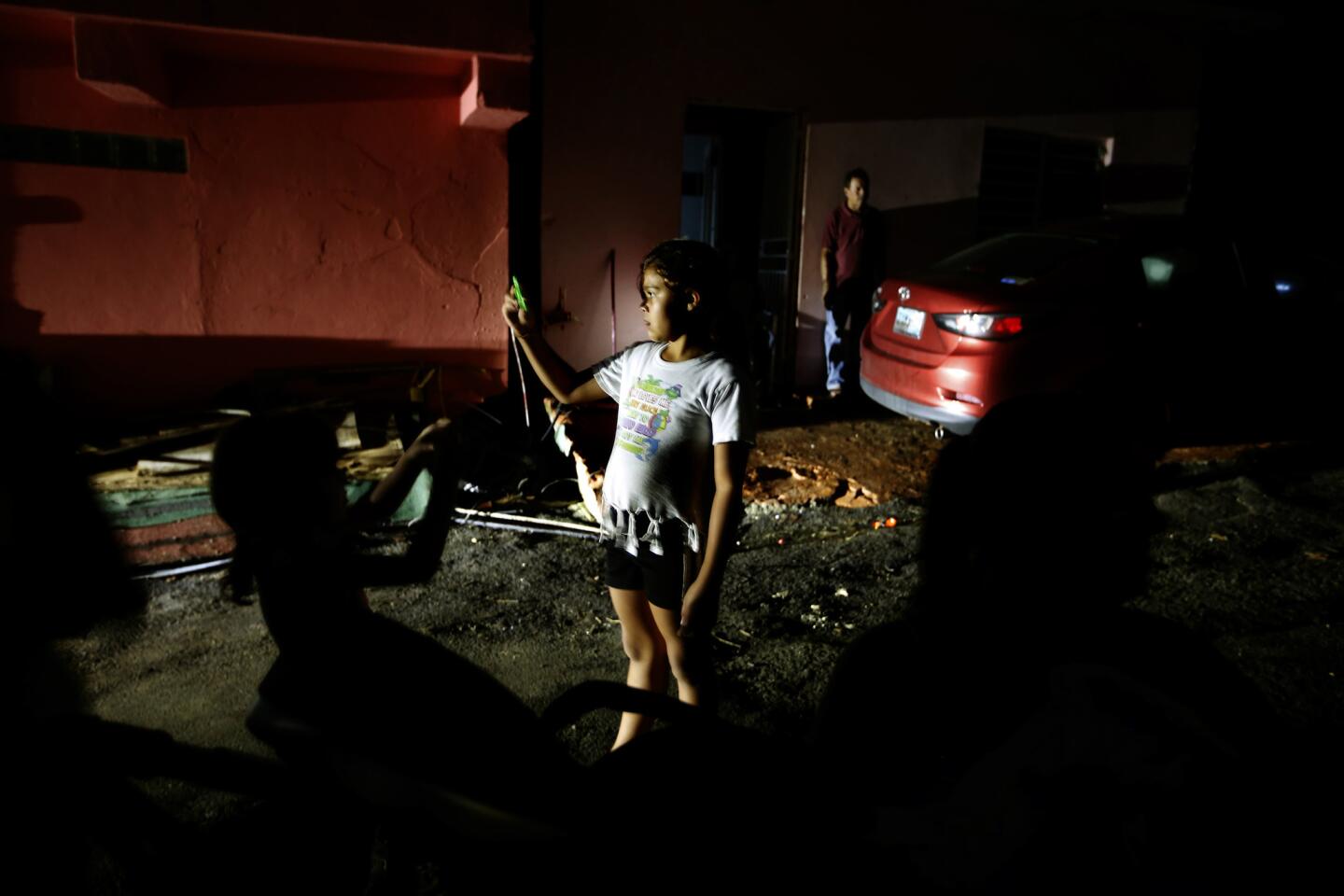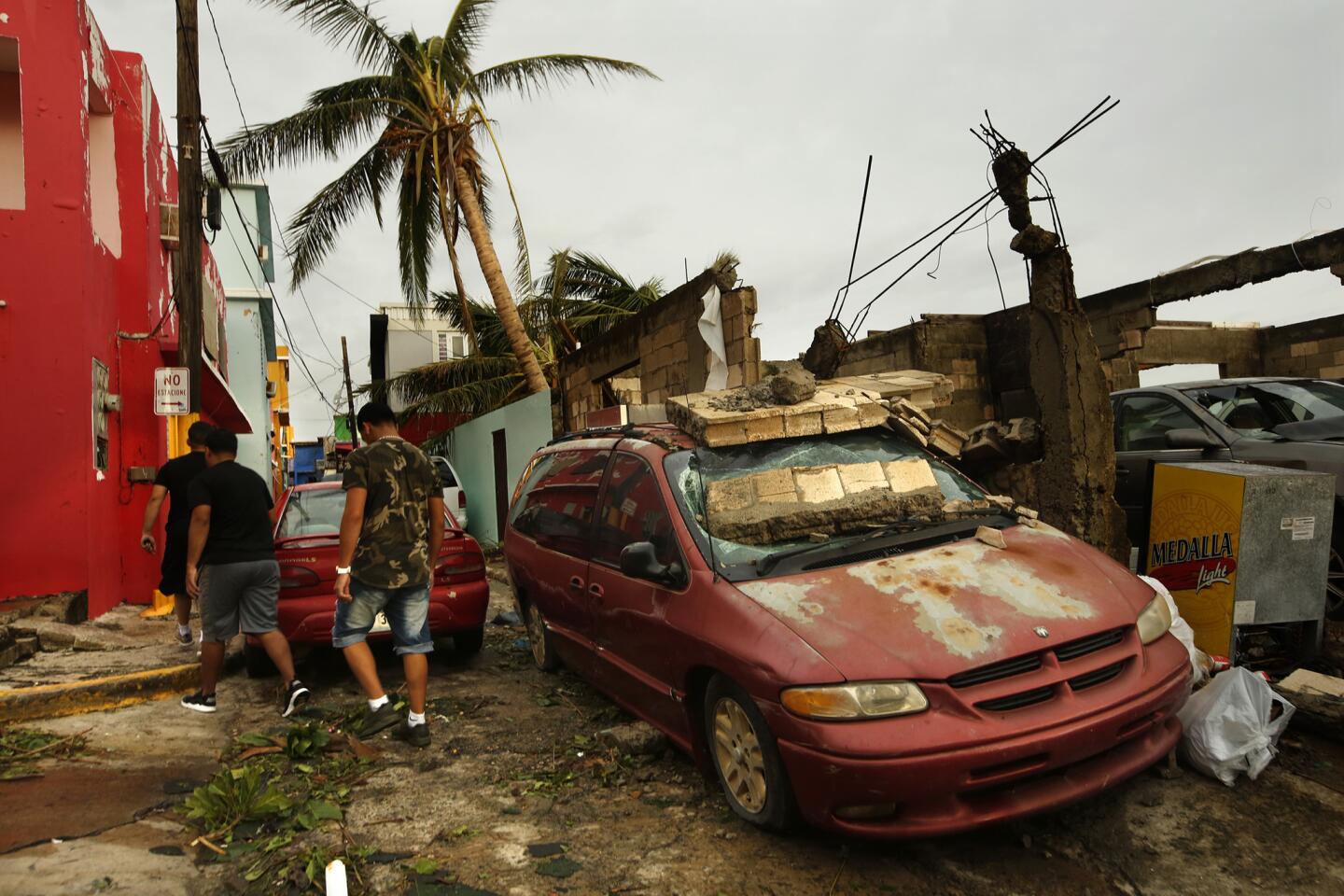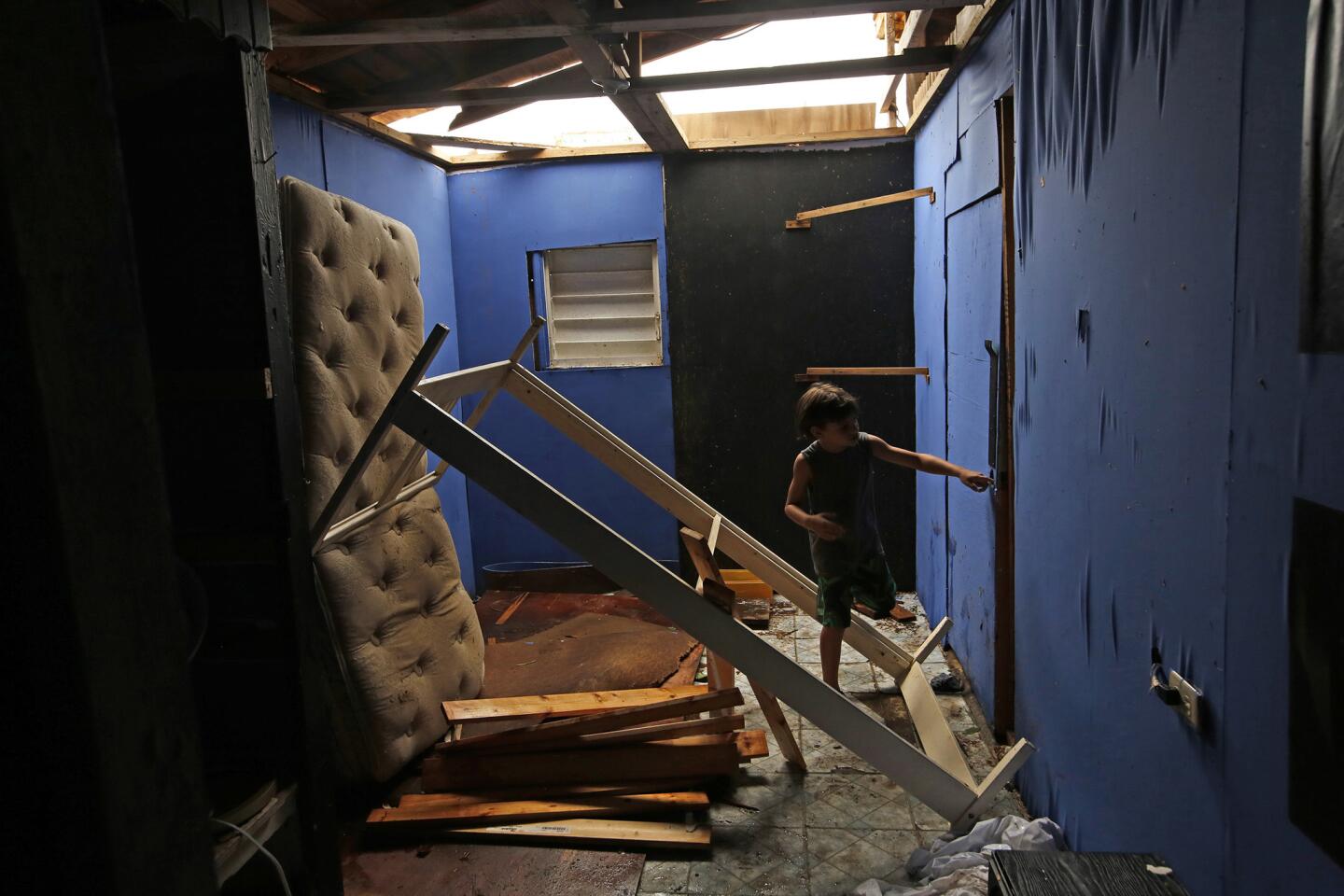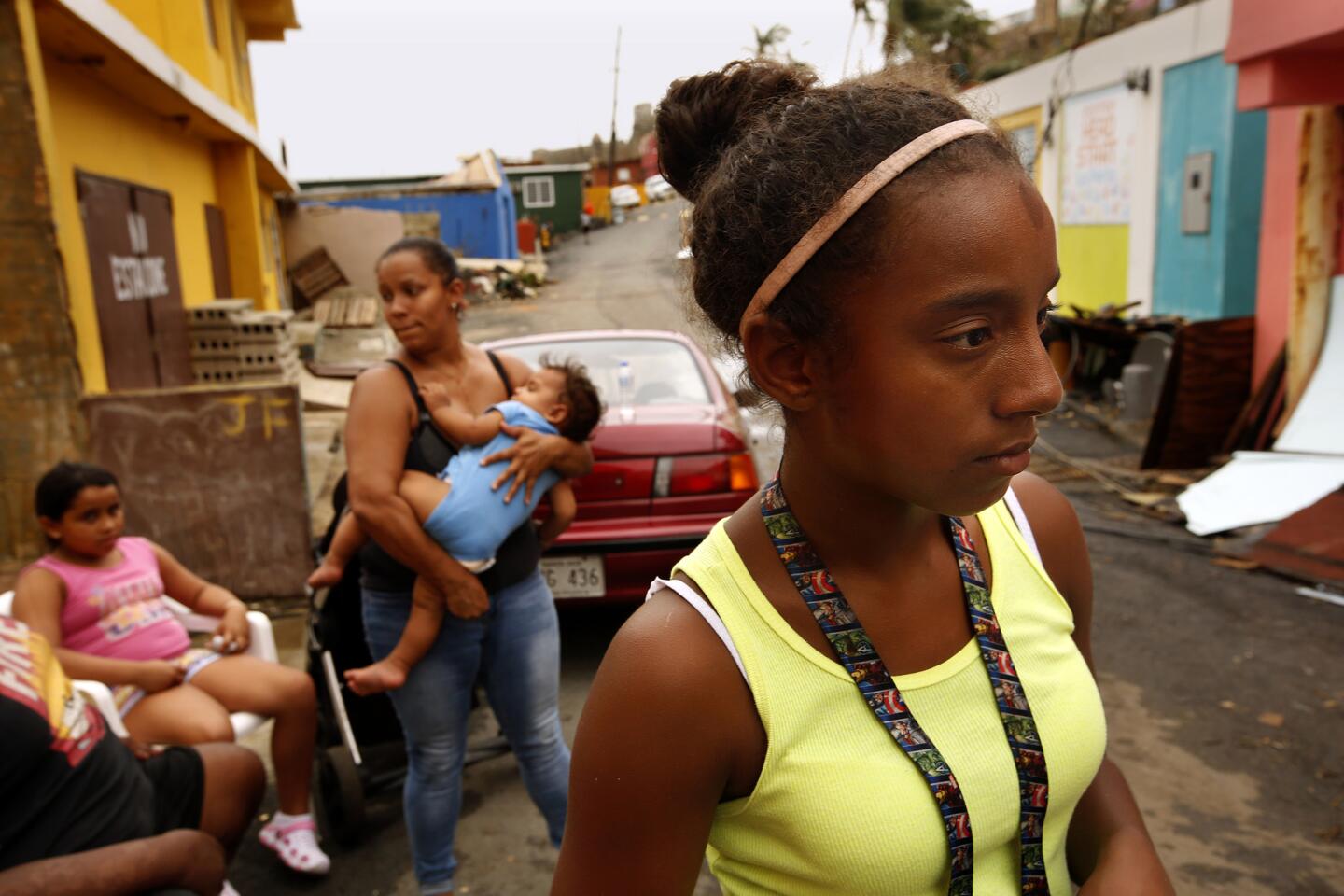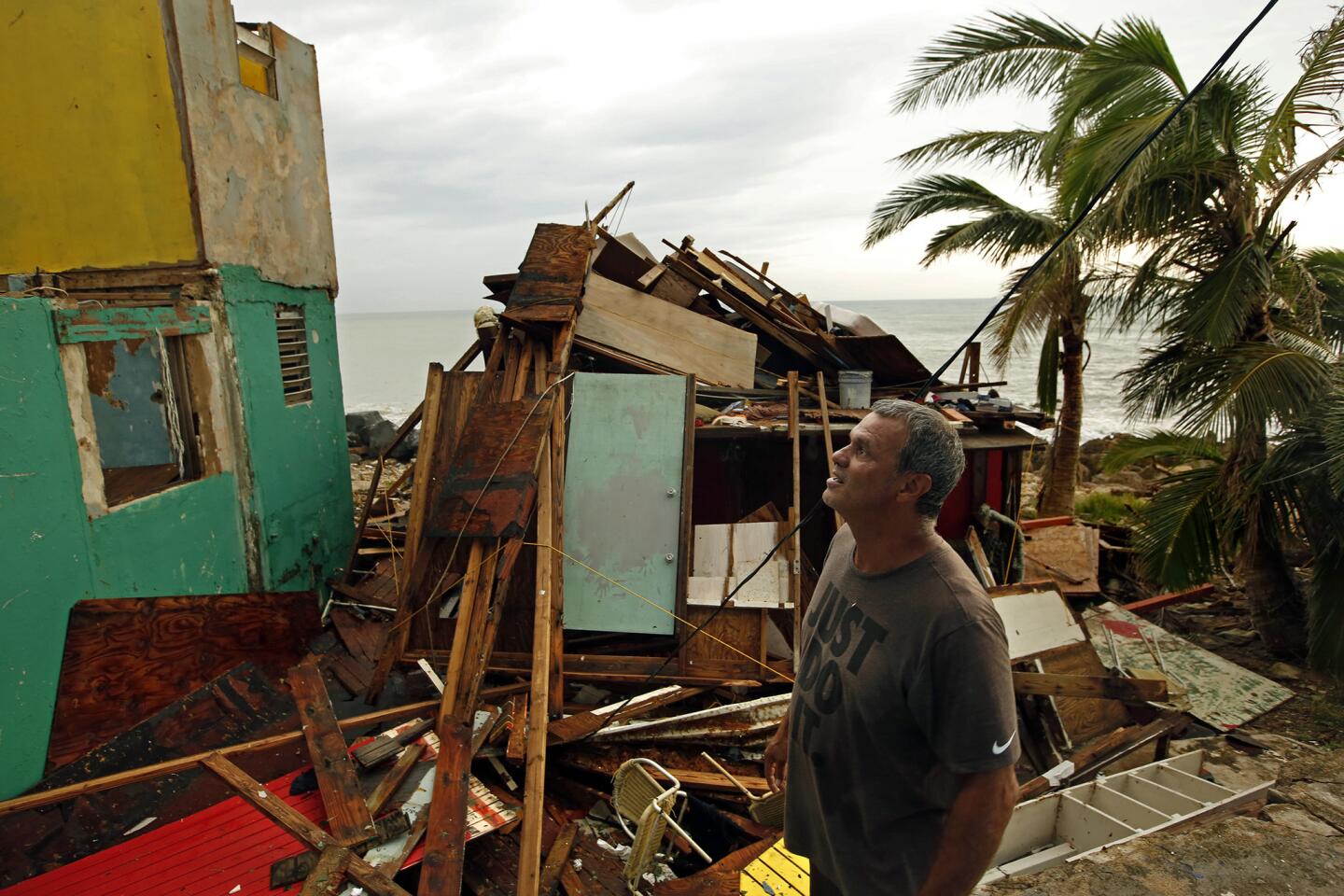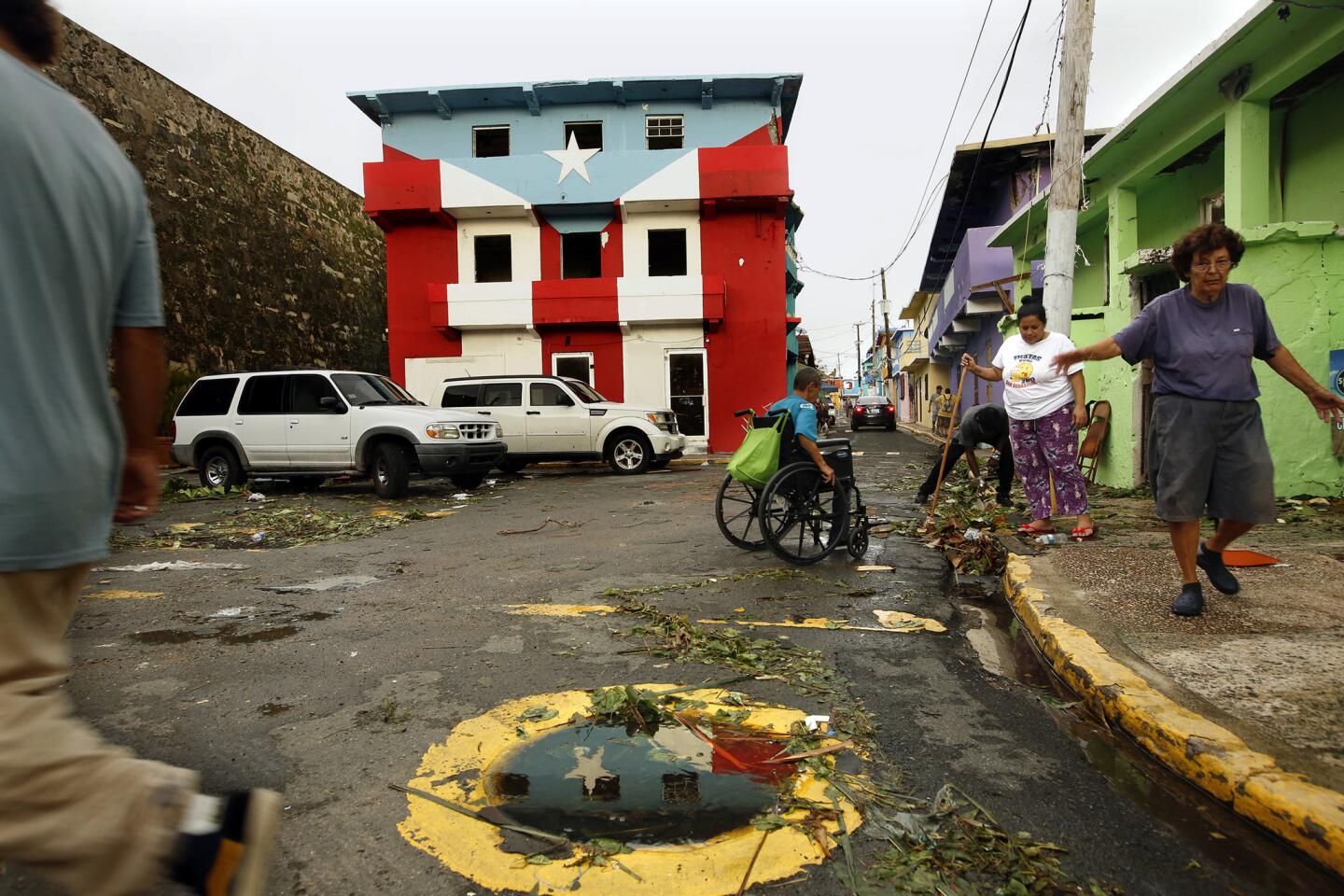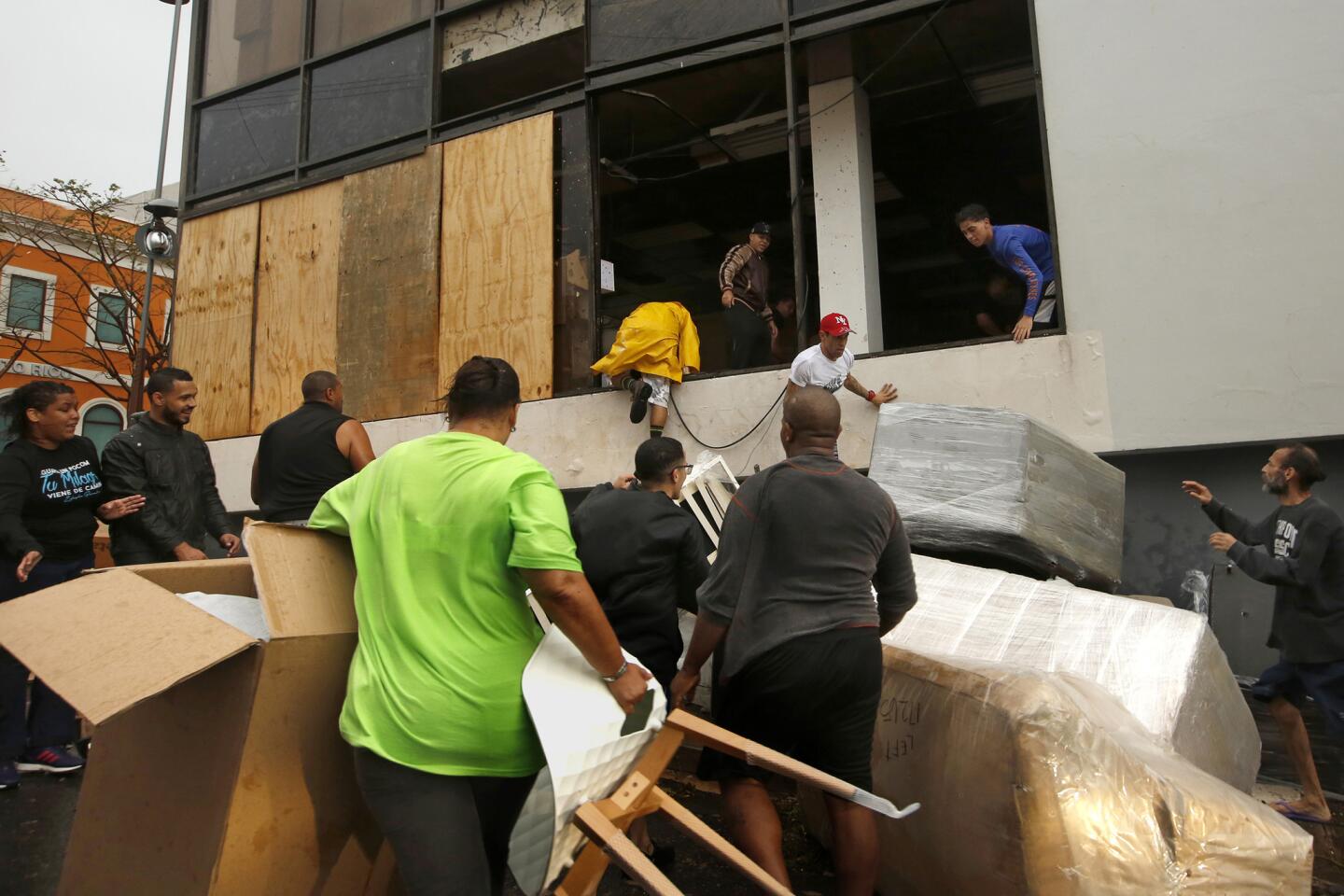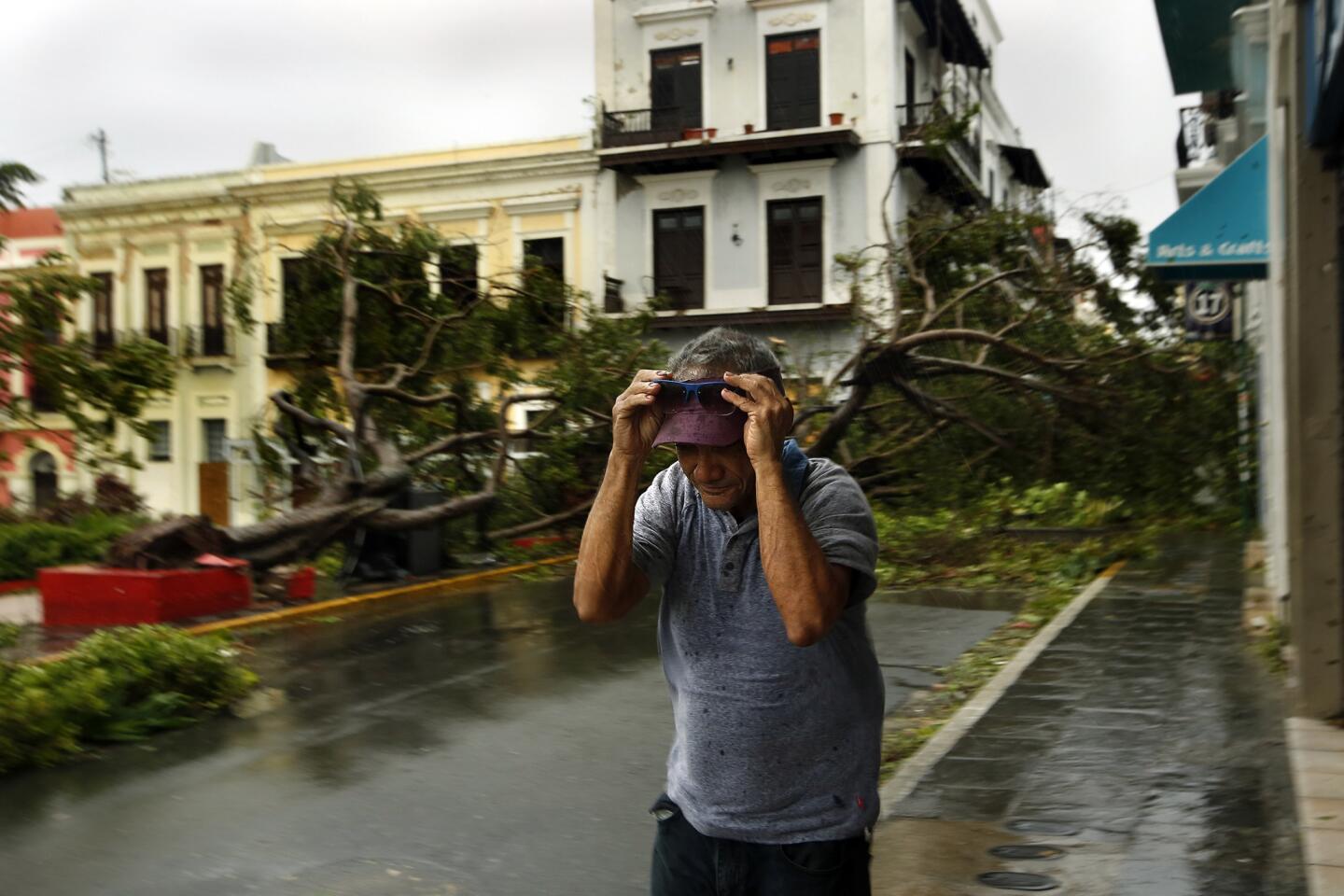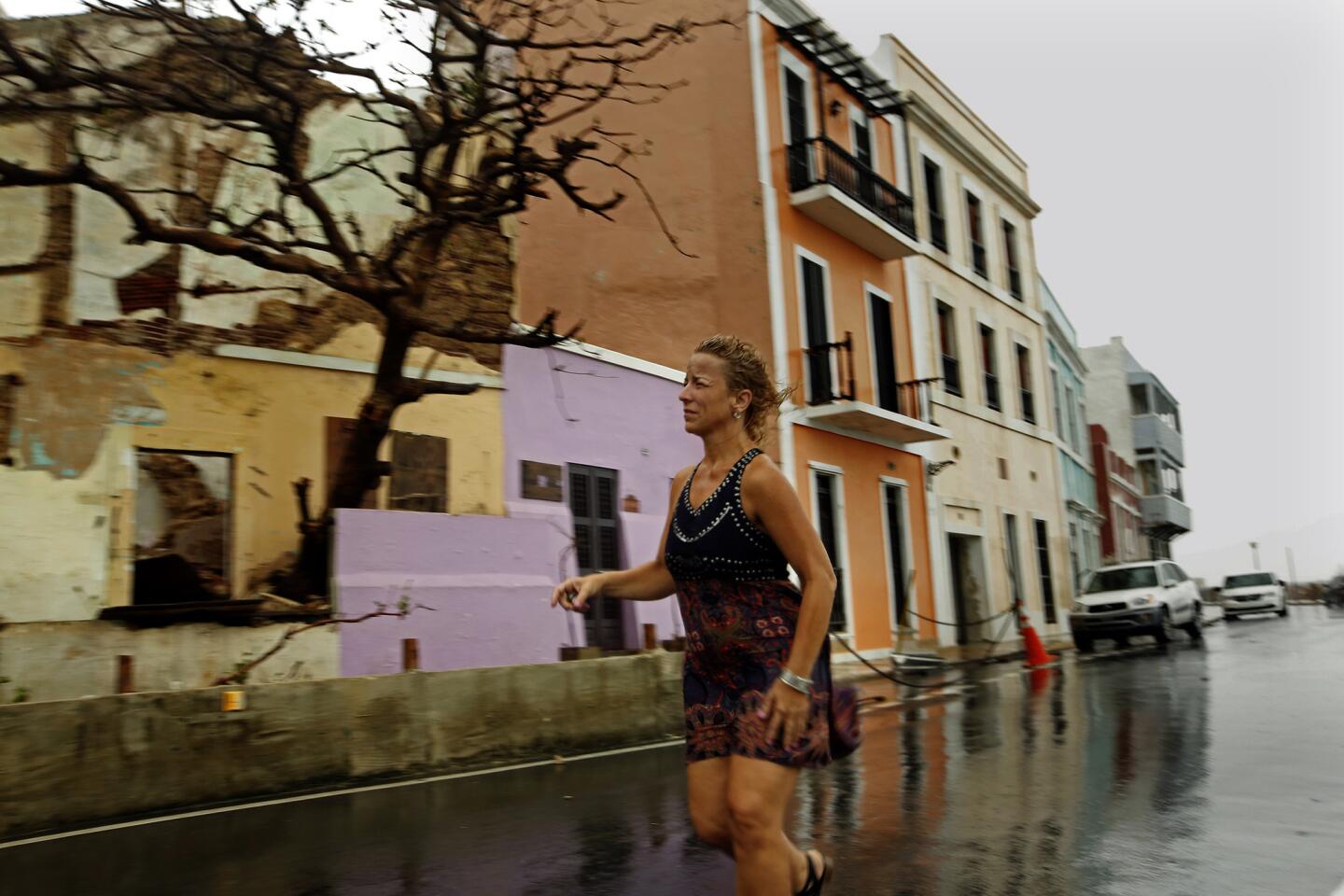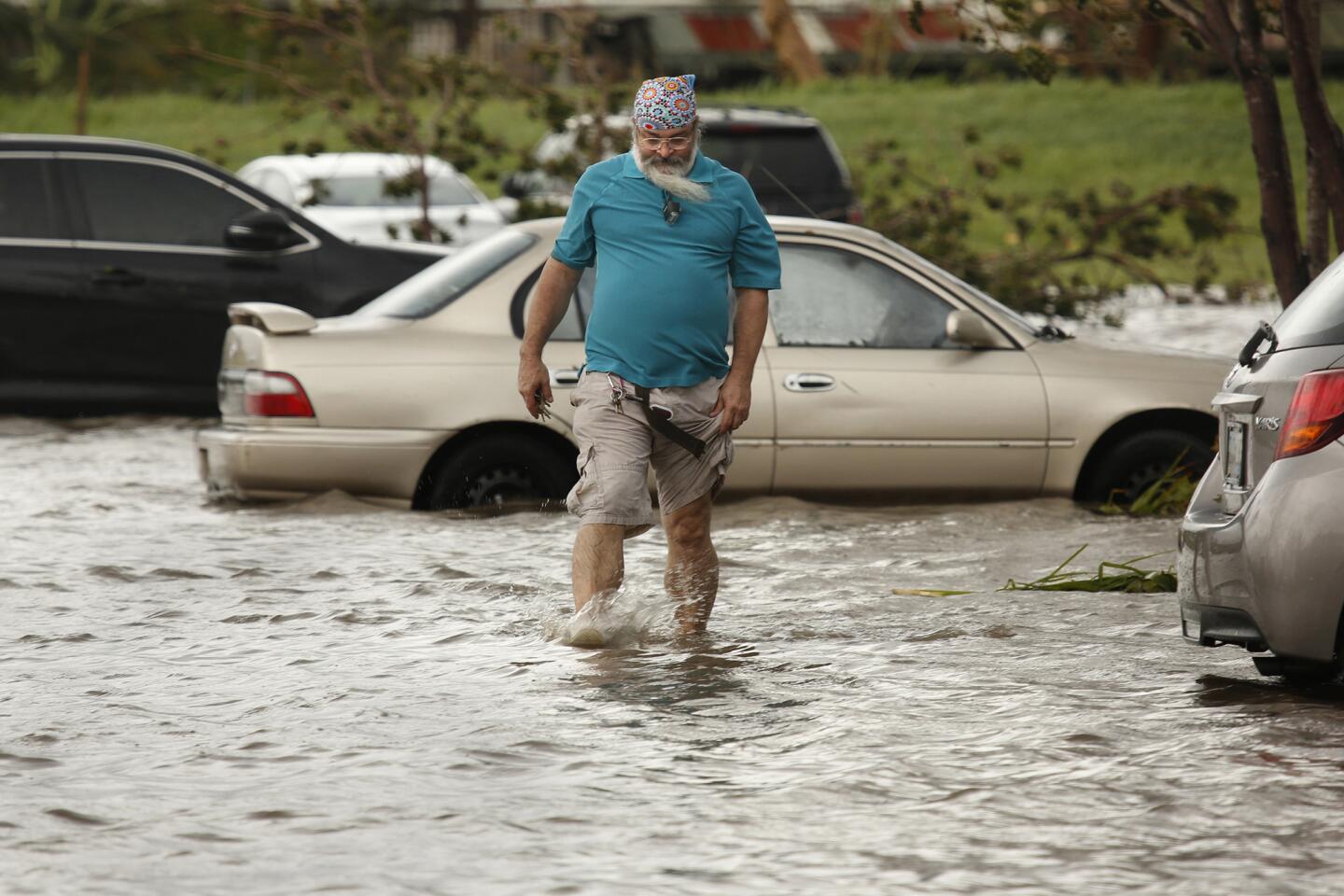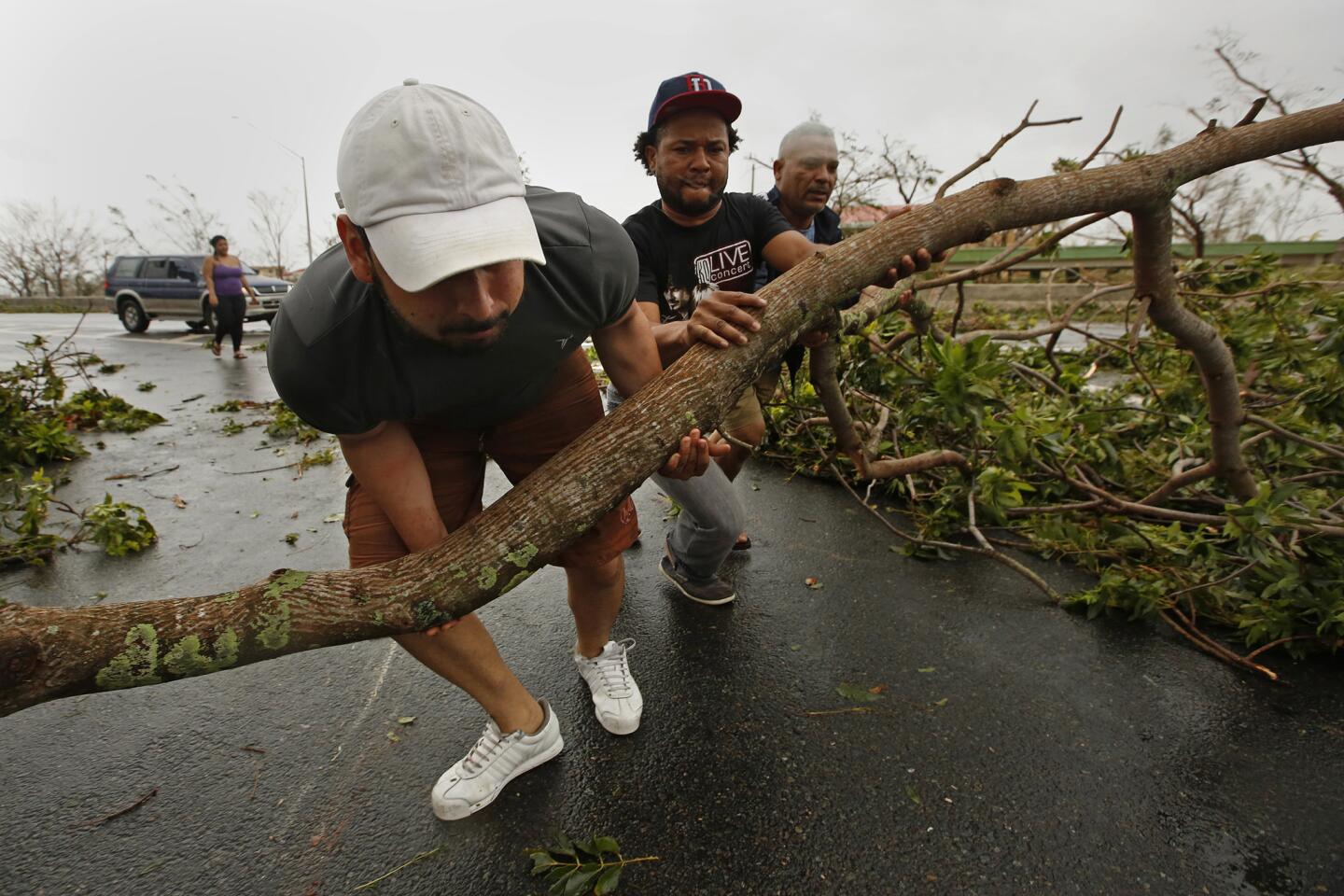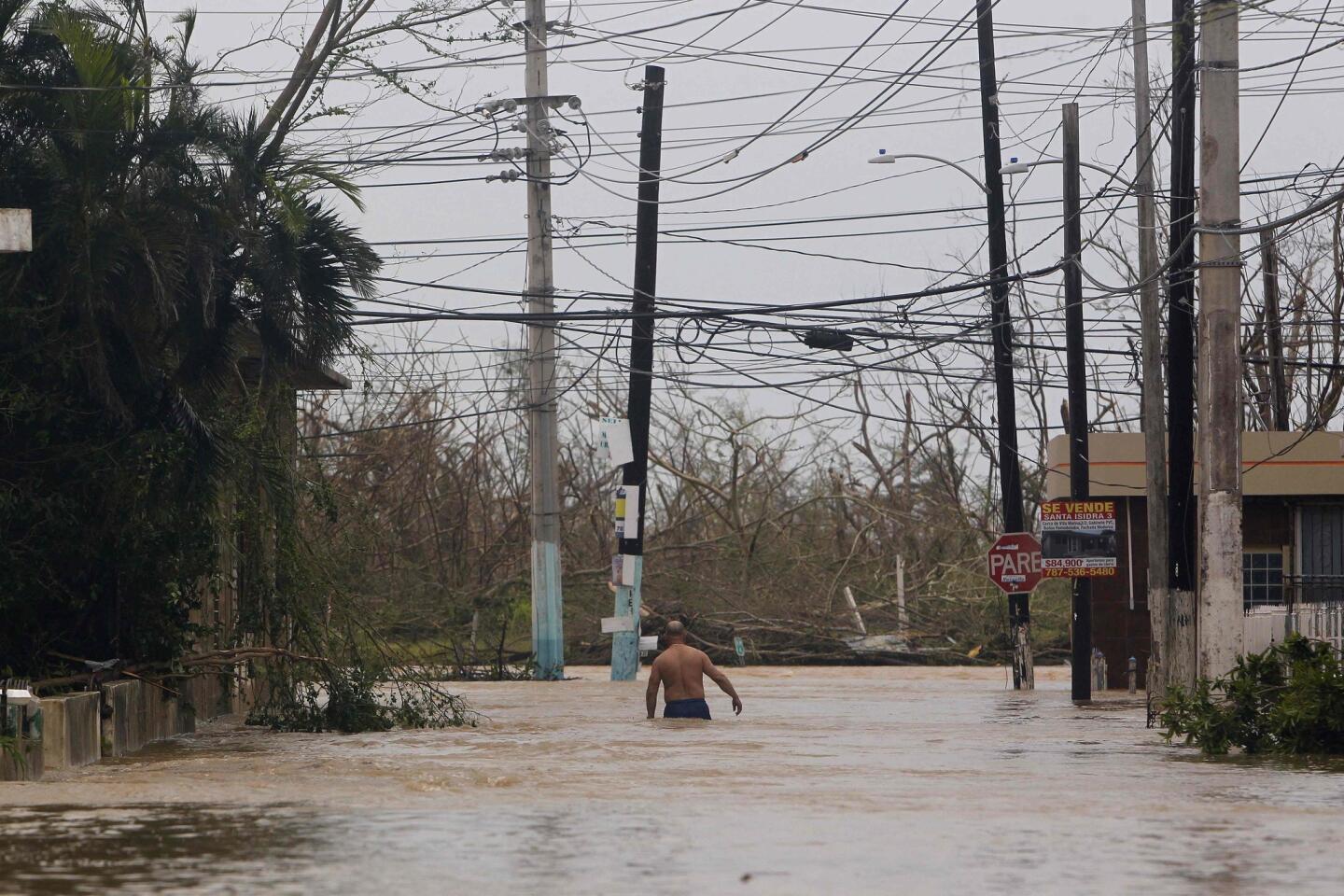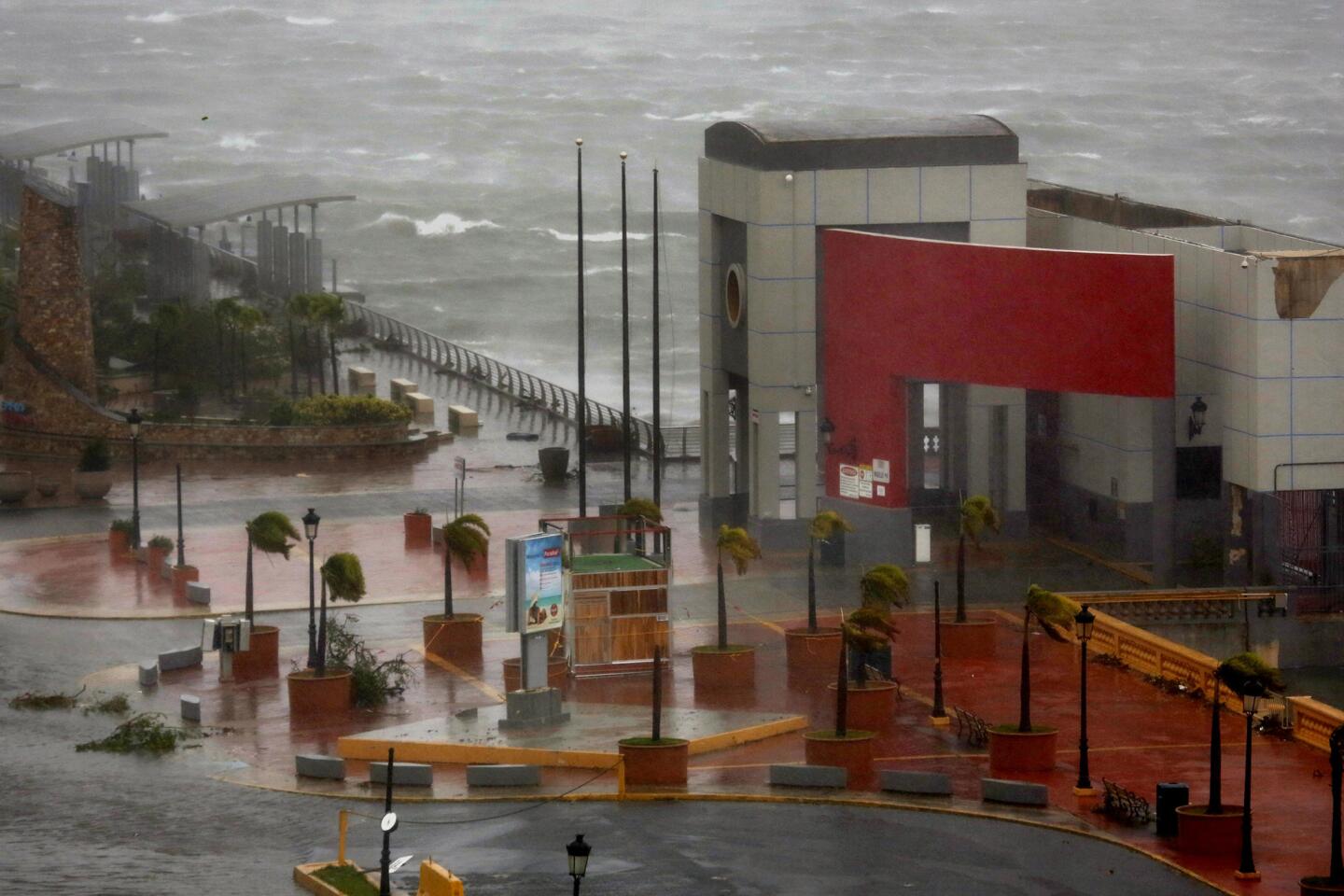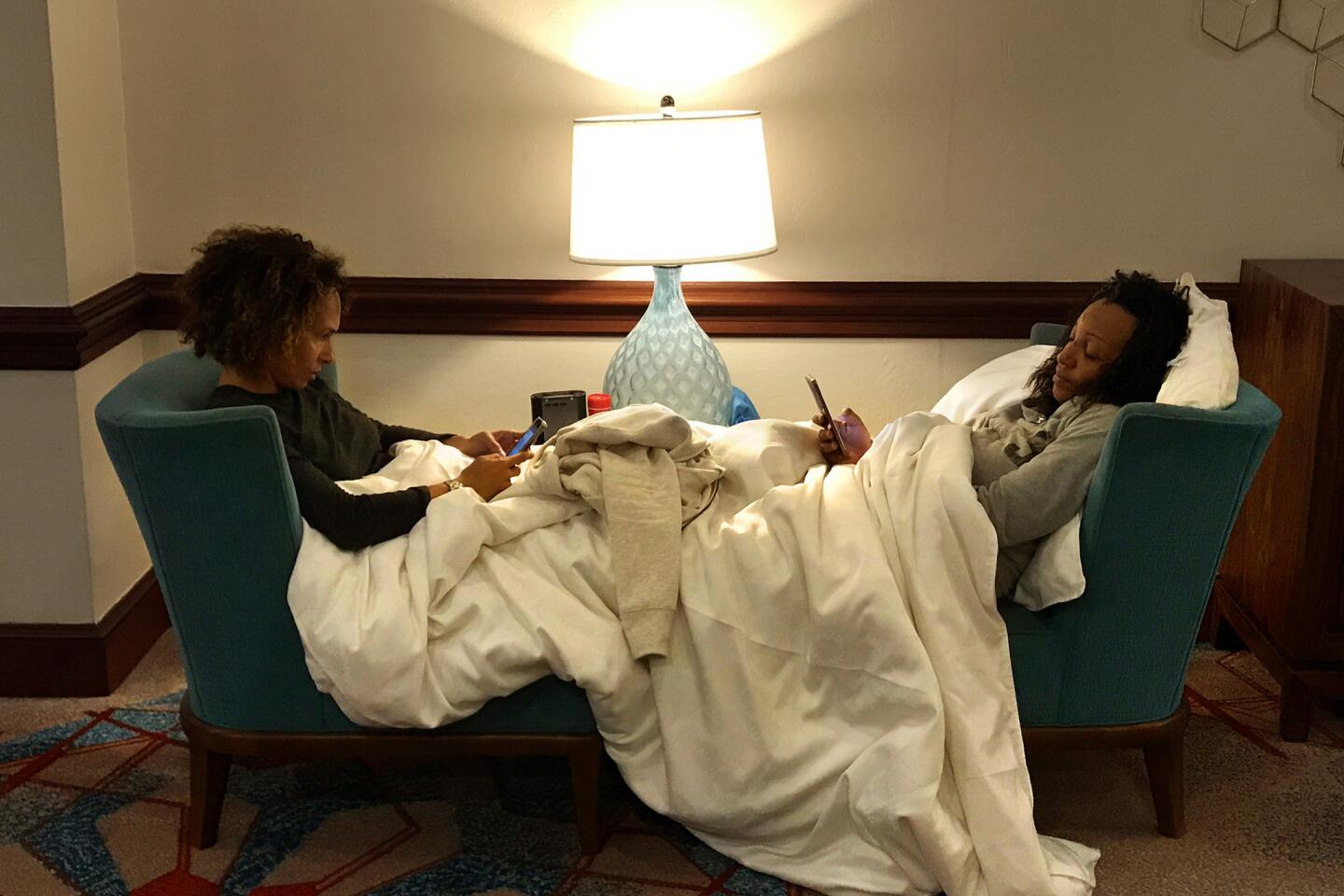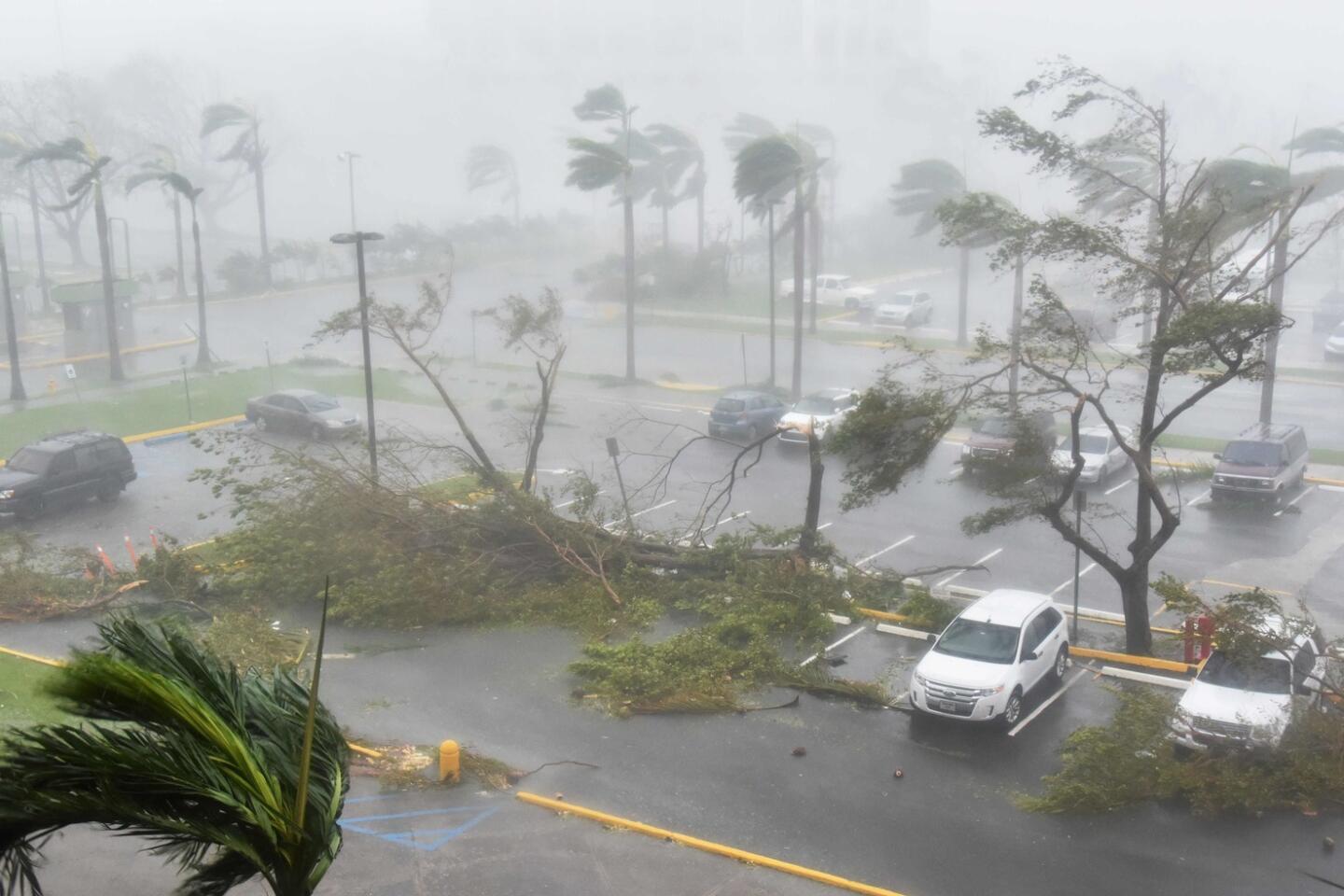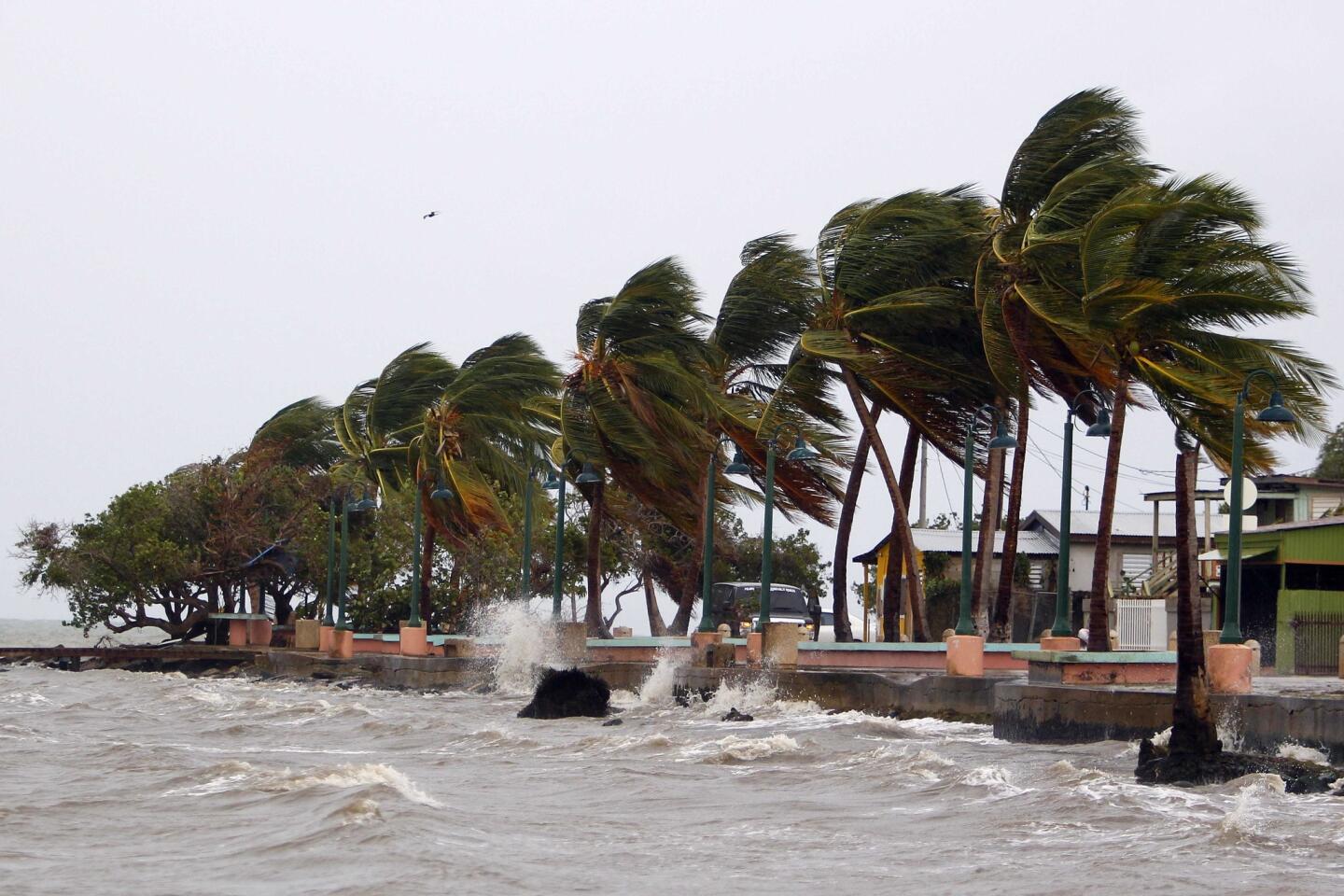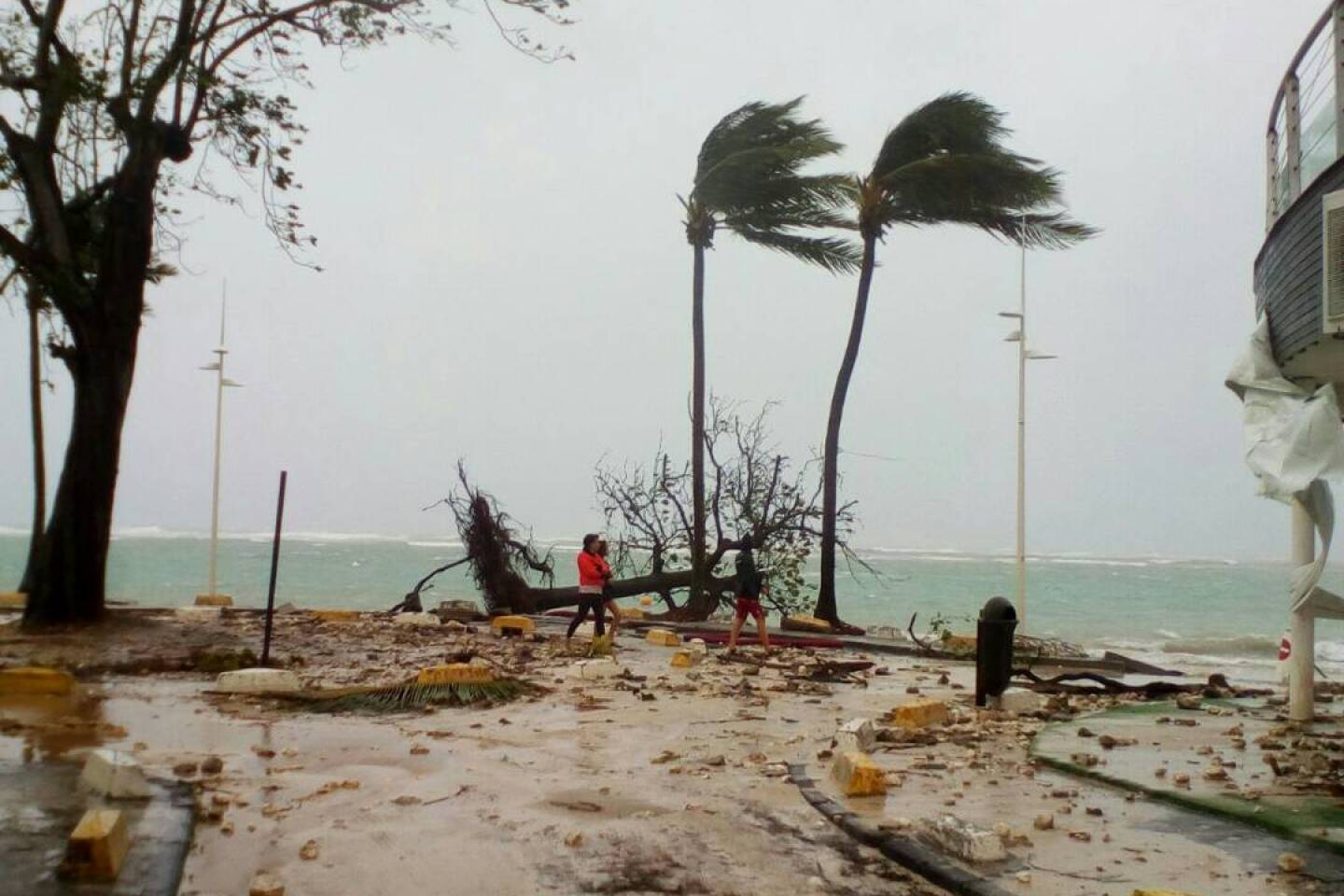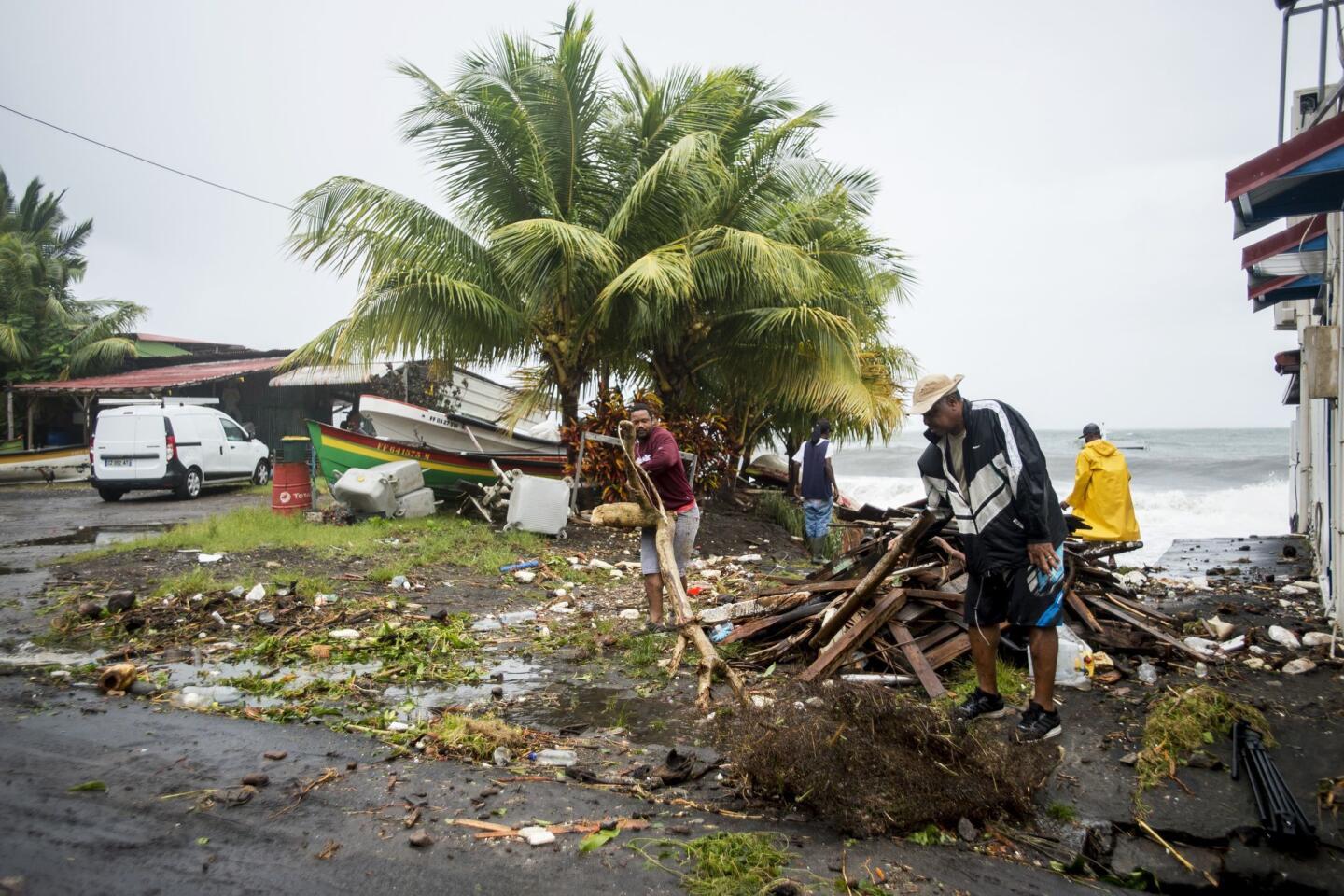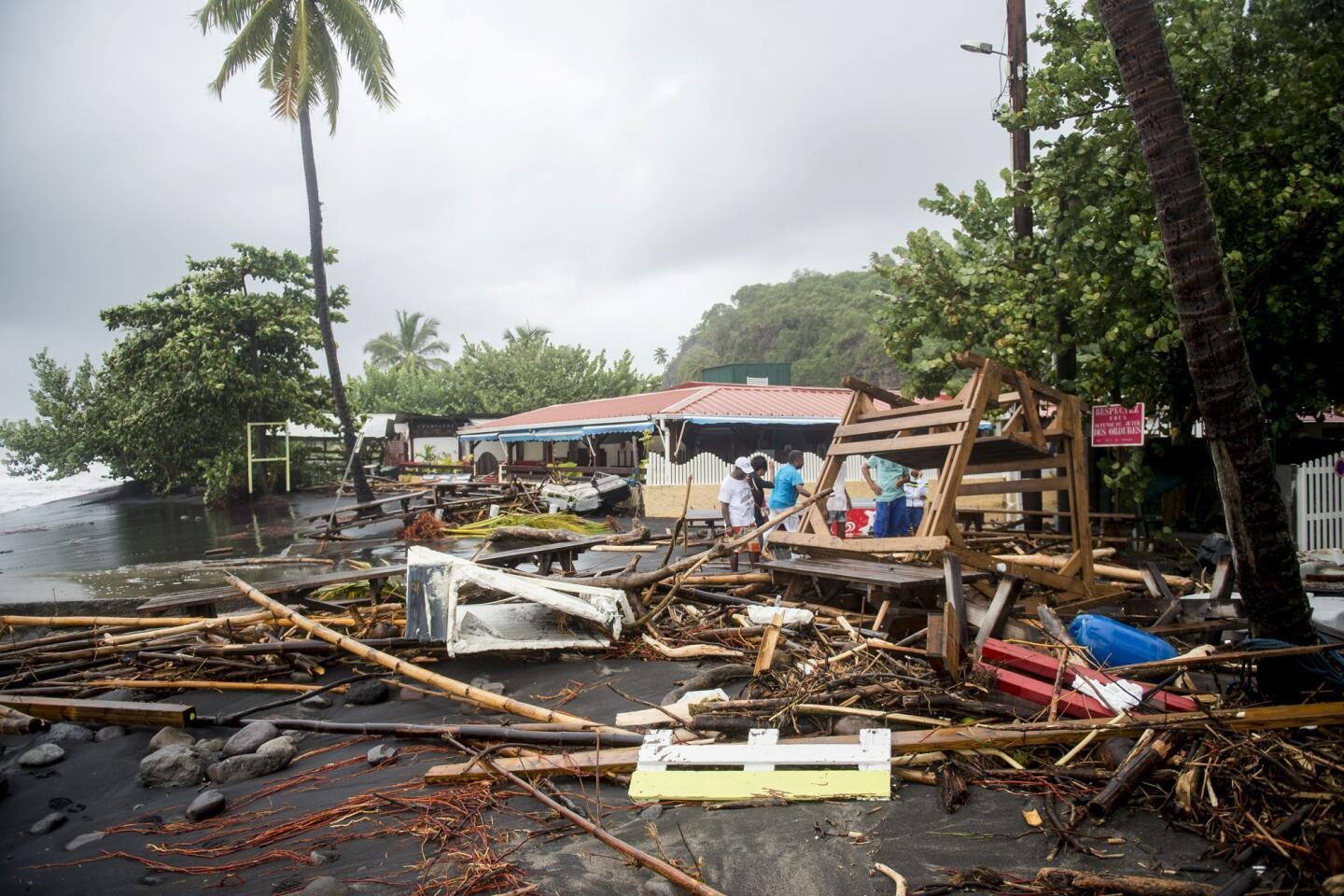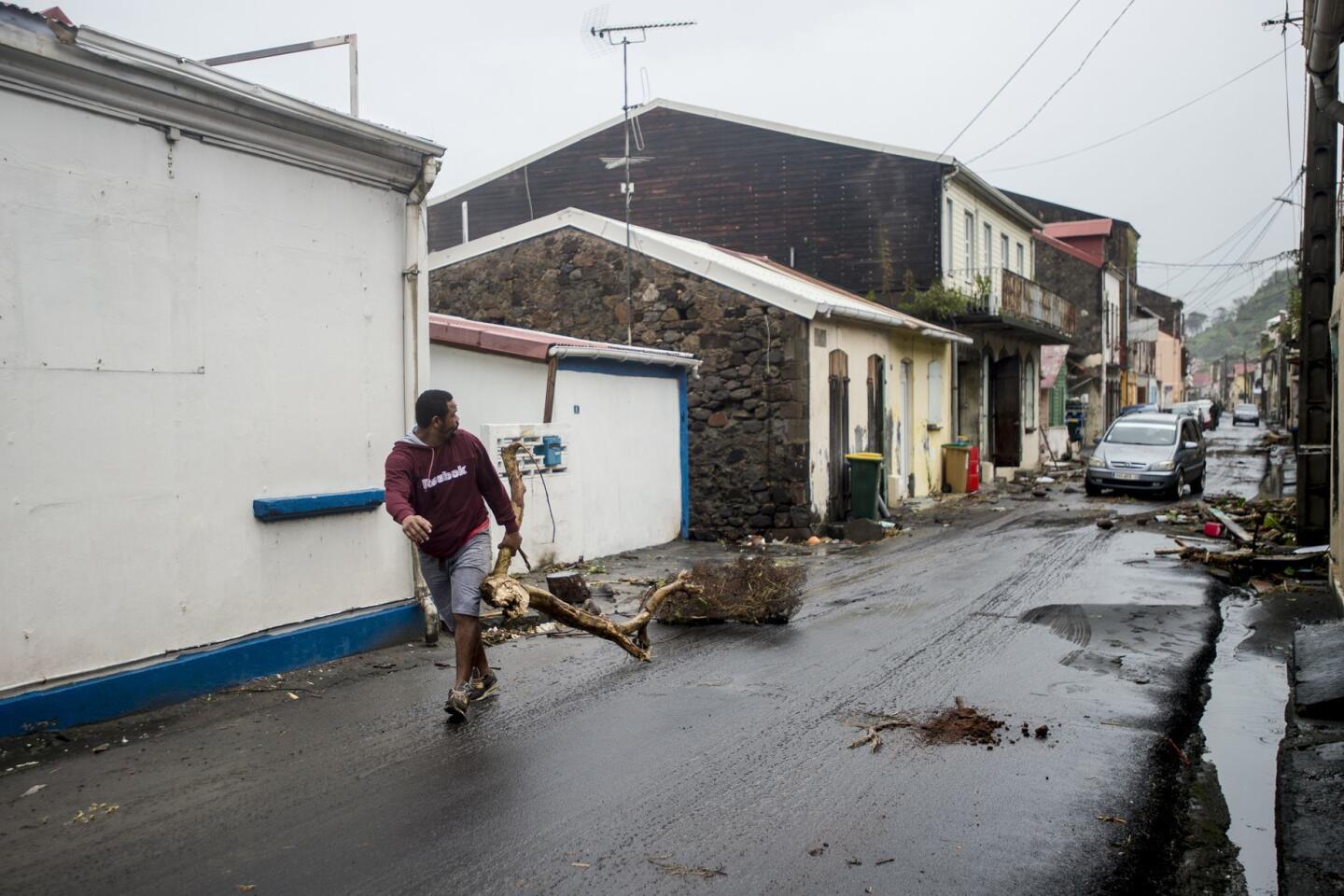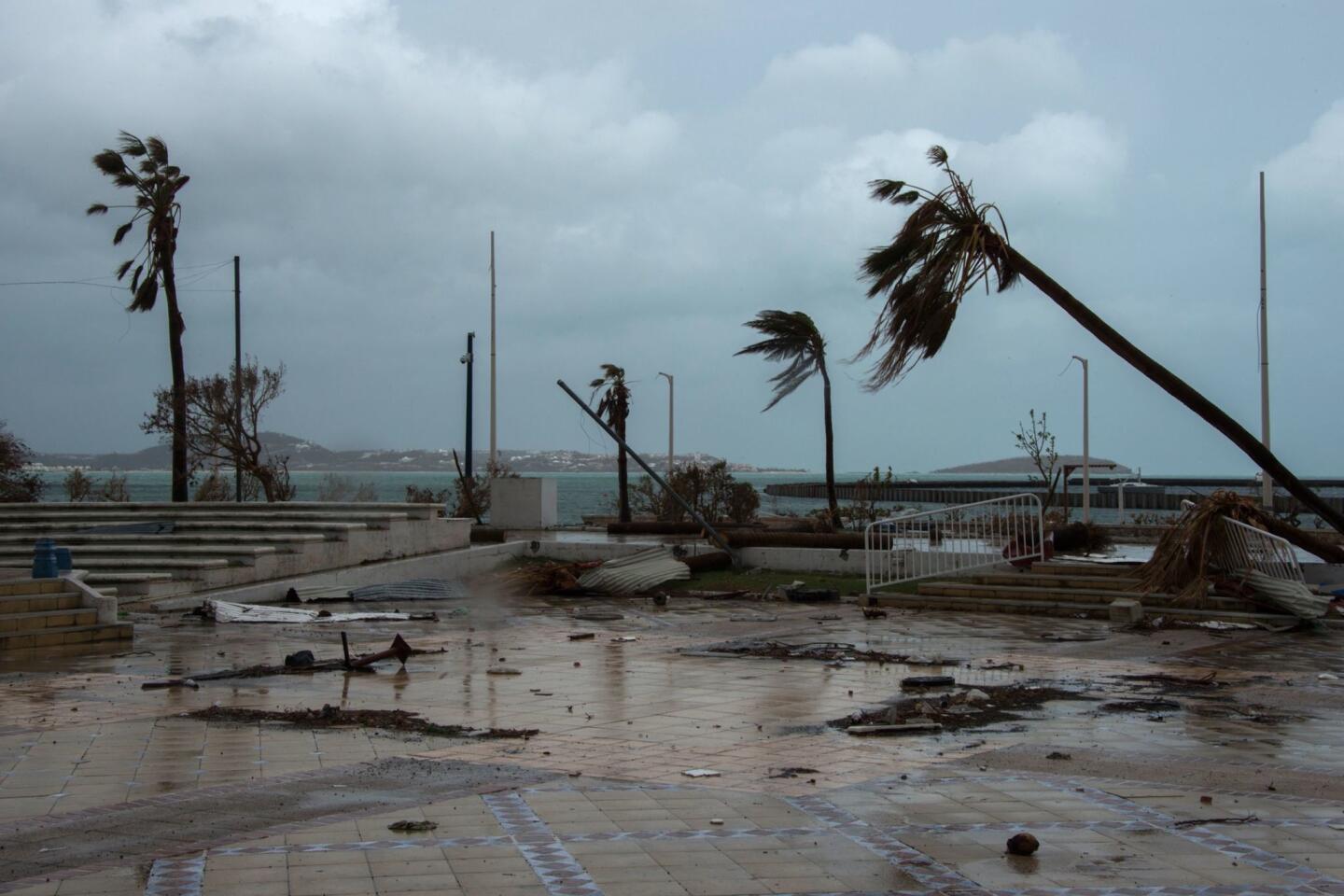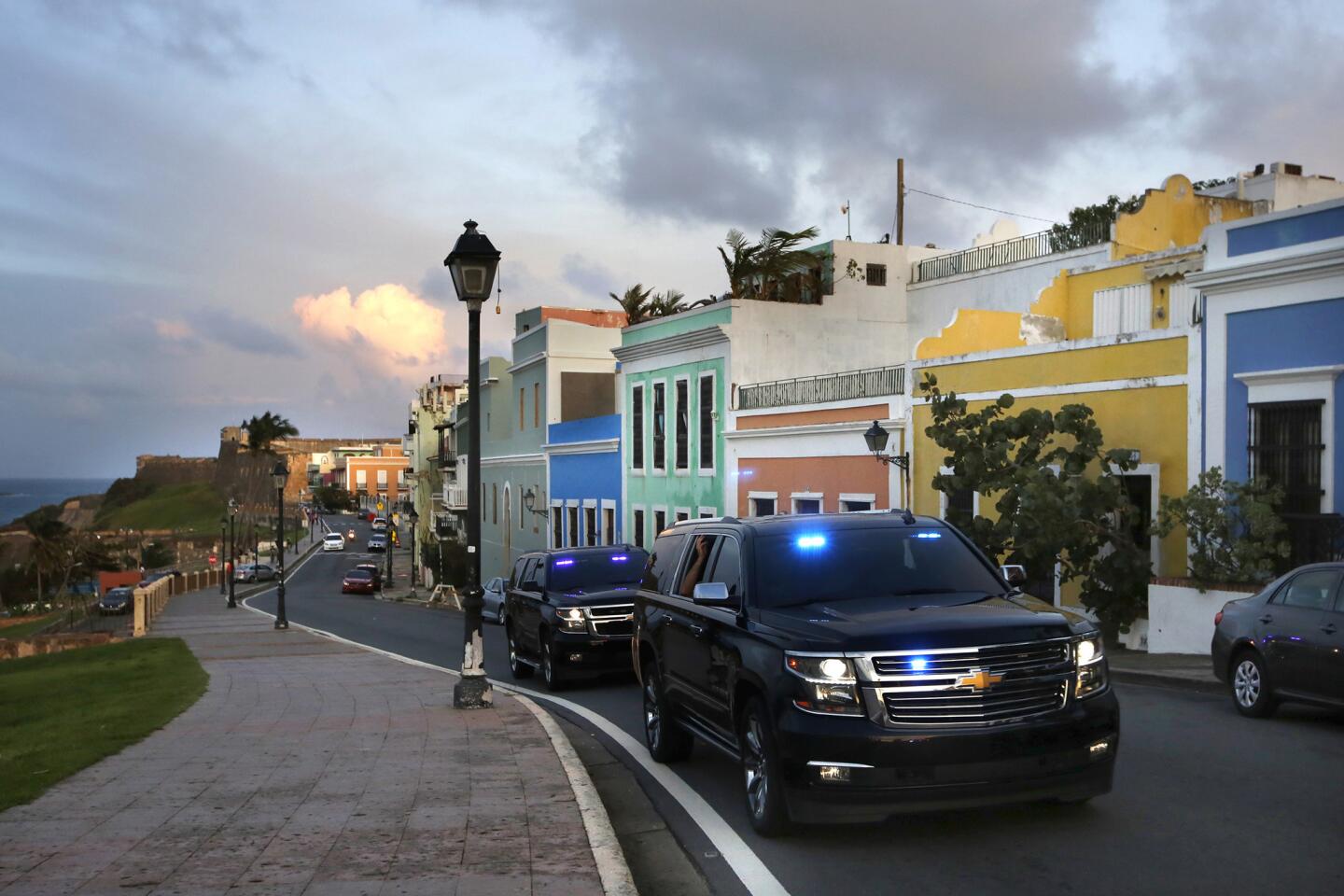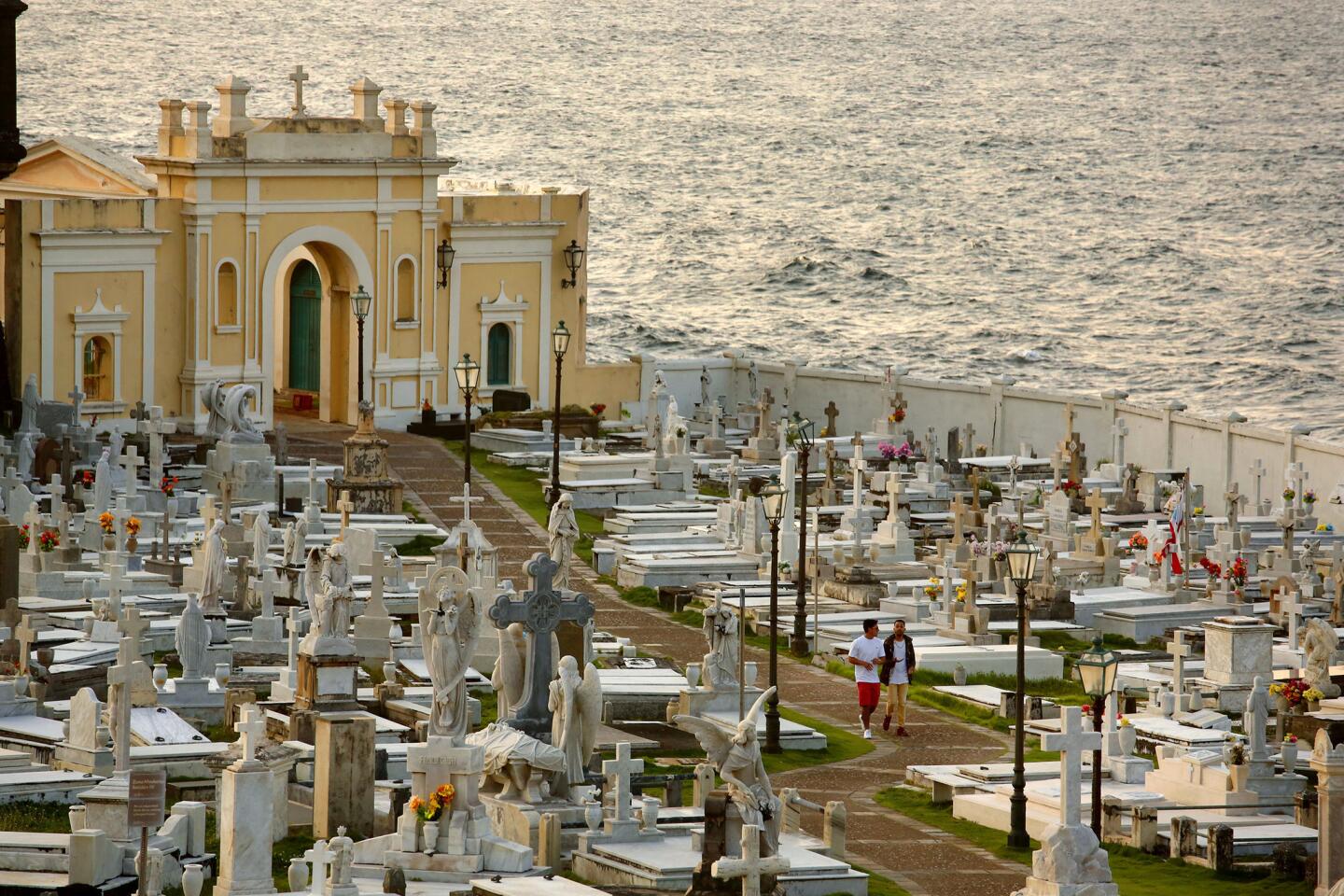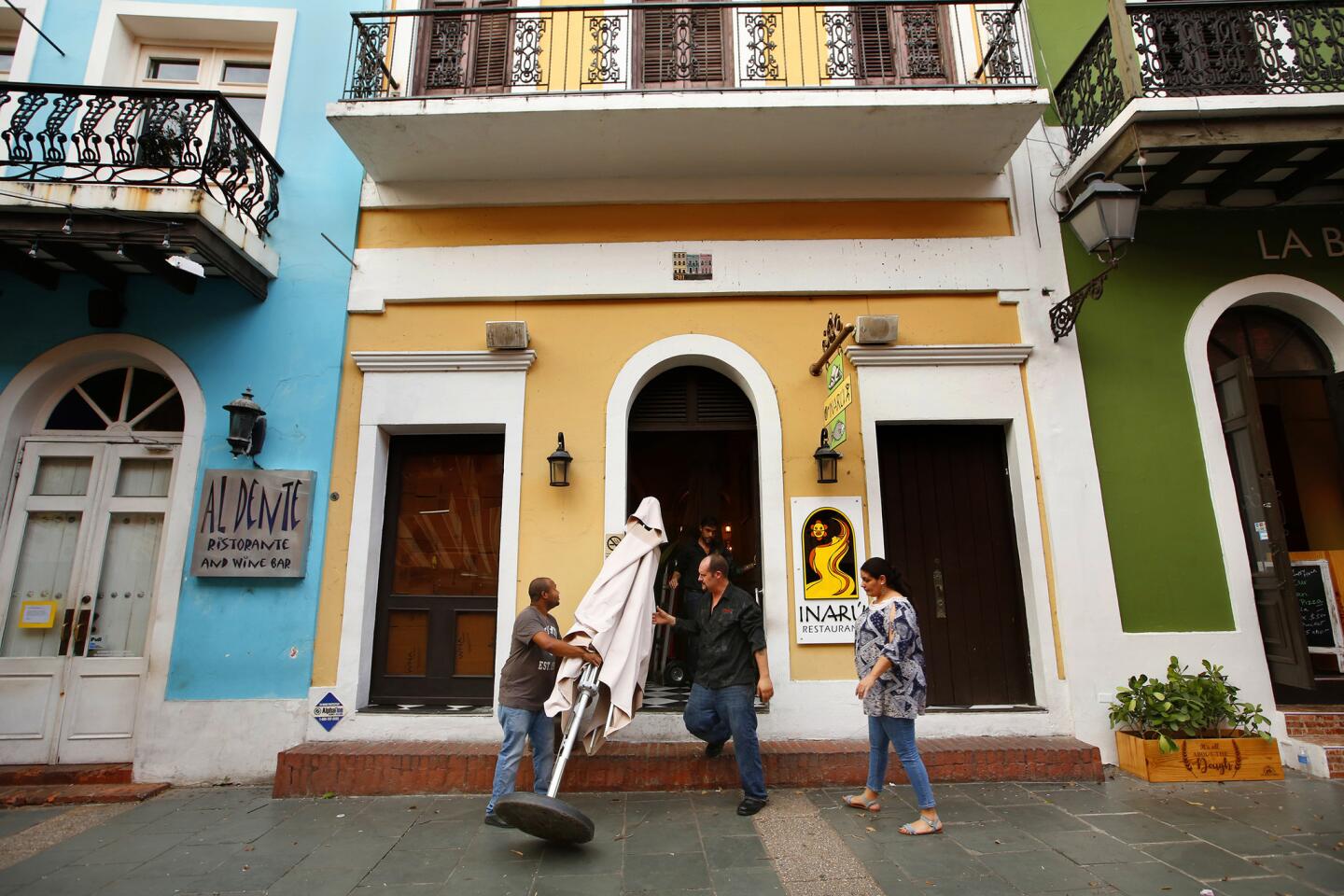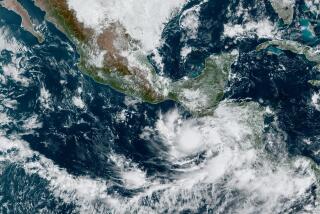Hurricane Maria rips through the eastern Caribbean on its way to Puerto Rico
Puerto Rico and the U.S. Virgin Islands were bracing for possible catastrophe as they remained locked in the crosshairs of Hurricane Maria, a Category 5 storm that has already devastated the Caribbean island of Dominica and was continuing to gain strength Tuesday.
“Now is not the time to wait,” San Juan Mayor Carmen Yulin Cruz said in a televised plea for people in high-risk areas or rickety homes to evacuate to government-run shelters. “Now is the time to accept the reality of what’s going to happen.”
Speaking from the Roberto Clemente Coliseum, where more than 500 evacuees were hunkering down, she warned that the storm would probably shut down communications and could leave the city of about 400,000 without power for months.
“We will keep in contact with the outside world as long as we can,” the mayor told reporters.
The storm was packing sustained winds of nearly 175 mph and gusts even faster. The eye, a “pinhole” just 10 miles wide, was expected to move near or over St. Croix in the U.S. Virgin Islands late Tuesday and cross Puerto Rico on Wednesday, according to the National Hurricane Center in Miami.

The hurricane briefly weakened to Category 4 on Tuesday but soon returned to a maximum Category 5 and was upping its wind speeds into the evening. Forecasters said the storm surge could raise water levels by as high as 11 feet.
When Maria made landfall in Dominica on Monday, it carved a path of devastation.
“The winds are merciless! We shall survive by the grace of God,” Prime Minister Roosevelt Skerrit wrote in one of several Facebook posts chronicling the storm from his official residence.
He said he could hear the sound of the storm stripping away steel roofs, including his own: “Rough! Rough! Rough!”
“So far the winds have swept away the roofs of almost every person I have spoken to or otherwise made contact with,” he wrote after being rescued.
In an appeal for international aid, he wrote, “We will need help of all kinds.”
On the French island of Guadeloupe, at least one person was killed after being hit by a falling tree, officials said. It was the first death attributed to Maria. Two people were reported missing after their boat sank off La Desirade island, where 80,000 homes were left without power, the Associated Press reported.
On nearby Martinique, officials said, about 25,000 homes were without power, and two towns were without water after the storm passed.
In St. Croix, U.S. Virgin Islands Gov. Kenneth Mapp predicted that Tuesday would be “a very, very long night.”
“Forget about your house, about how much property you have in your house, and concentrate on your family,” he warned residents, urging them to move to shelters.
The other main U.S. Virgin Islands, St. Thomas and St. John, are still recovering from a direct hit by Hurricane Irma, which caused four deaths, destroyed scores of homes and stripped vegetation off the hills.
Chris Wachta’s home was among those damaged. He had been on vacation in Europe with his wife celebrating their 25th wedding anniversary when the storm struck. Unable to return, he struggled to help his pet sitter escape with his dog and three cats. She finally joined him and his wife in San Juan on Monday.
“We can’t get back to see what’s going on,” he said.
Wachta, 59, is a regional project director for Marriott Vacation Club and worried about colleagues still on St. Thomas, some living with their children in homes without roofs. His company was trying to place them in vacant rental properties before Hurricane Maria strikes.
“We’ve been moving them to safe havens,” he said.
In Puerto Rico, officials were calling Maria the “storm of the century.” If it makes landfall at Category 5, it would be the first to do so in nearly 90 years.
Old San Juan’s streets were largely empty Tuesday, storefronts along the water boarded up and some entrances fortified with sandbags. Police patrolled and prepared a shelter in City Hall. The skies were overcast most of the day, with spotty rain and strong surf.
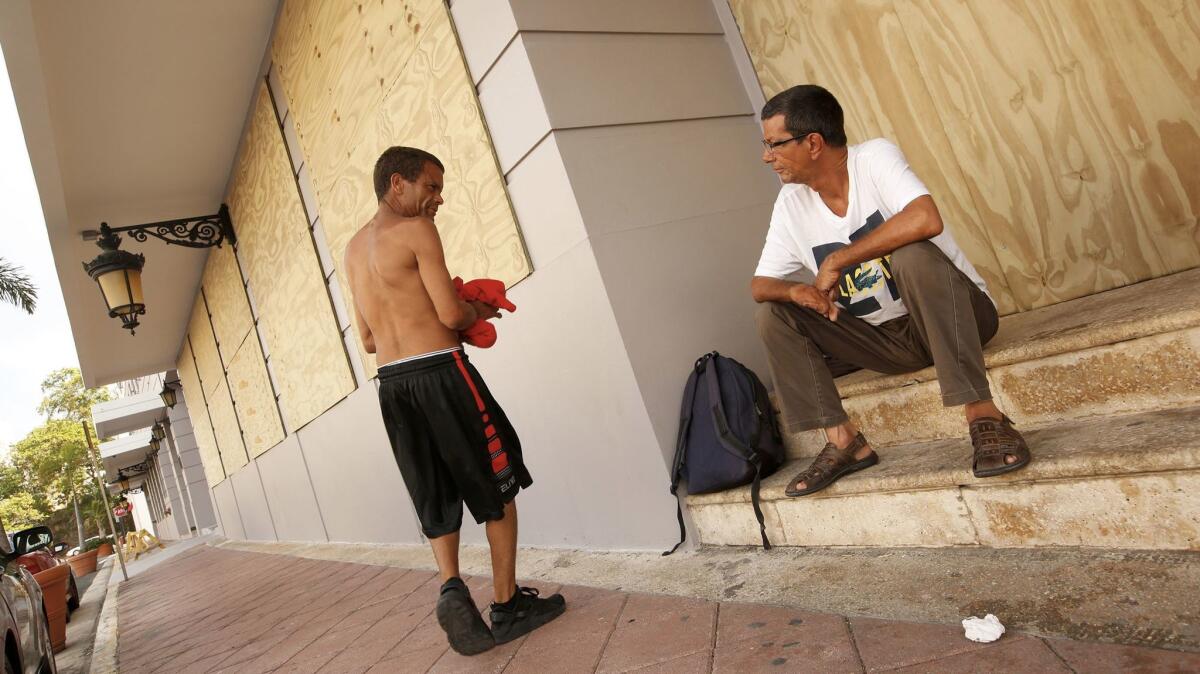
By the end of the day, about 12,000 people across the island of 3.4 million were in shelters. The eye of the hurricane was less than 160 miles from San Juan, the capital.
“We’re waiting to see what happens,” said Merian Morales, 31, who had evacuated to the coliseum with her husband, three children and Labrador retriever. They had not evacuated this month during Hurricane Irma, but this time heavier rains were predicted.
Maria Torrens, a 55-year-old accountant on a nearby cot, said she was expecting to stay two nights. She could not persuade her sister to leave her oceanfront condominium.
“There’s a lot at home,” she said. “They don’t want to leave. They think the hurricane won’t come. They hope.”
Artist Cresenciano Sotomayor, 41, took his family to get last-minute supplies — paper towels and candles — Tuesday morning in Old San Juan.
“We just do our preparations as best we can,” he said.
Sotomayor said the island had done all it could to prepare, but he still worried about poor neighborhoods outside the capital. He hoped people would help one another after Hurricane Maria as they helped the other Caribbean islands after Irma, sending emergency supplies and other aid.
In the coastal town of Loiza, just east of the capital, families were boarding up the windows and doors of their cinder-block homes.
“It’s going to be catastrophic,” said Monica Pisarro, 49, as her brothers drilled plywood into place.
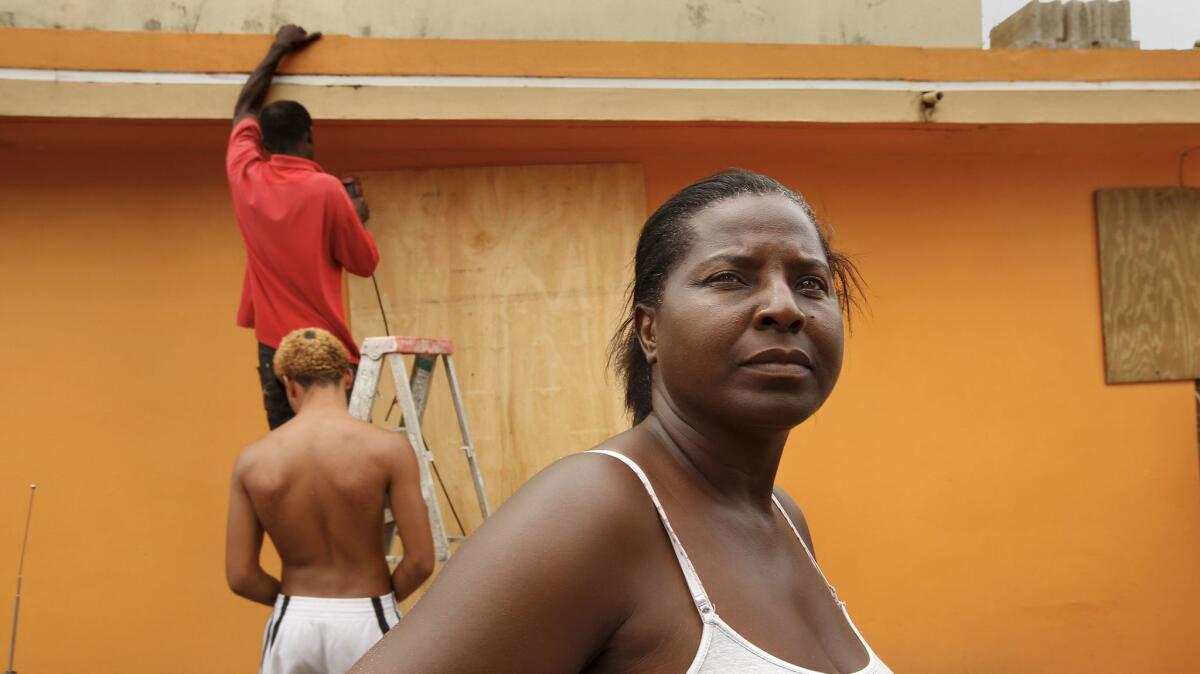
David Nieves, 28, waited in a long line with his family for $3 bags of ice, which his family intended to use to keep their meat from spoiling when the power went out. The family planned to take its chances and stay home during the storm.
Chent Quilichini, who works at a medical clinic for the poor and planned to get around after the storm on his bicycle, said he was worried about Puerto Rico’s vulnerable population.
“The island is in very bad shape economically, and now it’s going to be a catastrophic event,” he said.
Nearly 70,000 people in the U.S. territory were still without power llowing after Irma, and several hundred remained in shelters as Maria approached. Gov. Ricardo Rossello said that the island’s 500 shelters could house as many as 133,000 people and that the Federal Emergency Management Agency was prepared to supply drinking water and restore power after the storm.
Back at the coliseum, the San Juan mayor had a message for the large population of Puerto Ricans living in New York City, Orlando, Fla., and elsewhere on the U.S. mainland.
“This is your country and this is your capital city,” she said. “Please pray for us, keep us in your thoughts and prayers. And be convinced as we are that we will overcome.”
ALSO
In Irma-devastated Virgin Islands, resolve blends with worry of being forgotten
Still reeling from Irma, U.S. Virgin Islanders scramble to evacuate ahead of another hurricane
Fearing a big earthquake isn’t enough. Here’s how to turn anxiety into action
UPDATES:
7:47 p.m.: This article has been updated with forecast information and scenes from Puerto Rico.
1:45 p.m.: This article was updated with rains from the storm lashing the Virgin Islands and Puerto Rico and additional details.
11:50 a.m.: This article was updated with the death of at least one person on Guadeloupe and a statement from U.S. Virgin Islands Gov. Kenneth E. Mapp.
This article was originally published at 7:15 p.m.
More to Read
Start your day right
Sign up for Essential California for news, features and recommendations from the L.A. Times and beyond in your inbox six days a week.
You may occasionally receive promotional content from the Los Angeles Times.

